|
|
|
EDWARD C. WALLER |
|
|
|
COPPER URN FRANCISCO TERRACE
APARTMENTS 1895
LEXINGTON TERRACE COMPLEX
MIDWAY GARDENS (WALLER JR.)
ROOKERY BUILDING LOBBY (1905) WALLER APARTMENTYS 1895
WALLER BATHING PAVILION
WALLER HOUSE REMODEL 1899
WALLER GATES WALLER STABLE & POULTRY HOUSE 1901
WALLER SUBDIVISION
WALLER WORKMEN'S COTTEGES |
|
|
|
|
Edward C. Waller was a successful Chicago Businessman, real
estate developer and an early client and patron of Frank
Lloyd Wright. According to Thomas A Hines (Frank
Lloyd Wright Field Guide, 2005, p.277), in 1886 Waller
purchased a large tract of land in River Forest which
bordered the Des Plaines River on the west, and Edgewood
Place on the East, three blocks wide. It also ran from Lake
street North for one block. According to Carla Lind,
Lost Wright, 1996, p.49, it was a 6 acre parcel.
Architect Daniel Burnham, Burnham and Root, designed the
original Waller House. The estate was large enough that Waller
had barns for horses and cows, a green house for growing fruits
and vegetable, and the Wright designed Poultry House for raising
chickens.
|
|
In
1893-4, Waller sold a lot on Auvergne Place, across the street
from his own house to William Winslow (1894 - S.24), who
commissioned Wright to design his home. In 1895, Waller
commissioned Wright to design the
Francisco Terrace Apartments
(1895 - S.030) (since demolished) and the Waller Apartments
(1895 - S.031), considered two of Chicago’s first low-income
housing. In 1898 Waller commissioned Wright to design a home for
himself. It remained a project, but was published in Inland
Architect in 1900. One year later, Wright remodeled
Waller’s
house in River Forest (1899 - S.047). It was demolished in 1939.
In 1901 Wright designed the Waller Gates (S.065) at Auvergne
Place at Lake Street, that lead to his estate. At the same time
he also designed the Poultry House and Stables (S.066) located
on his estate.
|
|
|
|
|
|
|
|
|
|
|
|
EDWARD C. WALLER HOUSE REMODELING (1899 - S.047) |
|
|
|
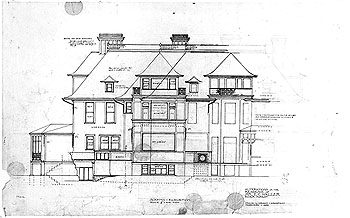 |
Date: 1899
Title:
Edward C. Waller Residence Remodeling, River Forest, IL 1899
(1899 - S.047).
Description: South Elevation of Frank Lloyd
Wright’s alterations to the Waller Residence in 1899. Edward C.
Waller was a successful Chicago Businessman, real estate
developer and an early client and patron of Frank Lloyd Wright.
According to Thomas A Hines (Frank
Lloyd Wright Field Guide,
2005, p.277), in 1886 Waller purchased a large tract of land in
River Forest which bordered the Des Plaines River on the west,
and Edgewood Place on the East, three blocks wide. It also ran
from Lake street North for one block. According to Carla Lind,
Lost Wright, 1996, p.49, it was a 6 acre parcel.
Architect Daniel Burnham, Burnham and Root, designed the
original Waller House. The estate was large enough that Waller
had barns for horses and cows, a green house for growing fruits
and vegetable, and the Wright designed Poultry House for raising
chickens. The house was located around the area where 520 - 528
River Oak Drive is today. River Oak Drive may not existed as a
street in 1899.
In
1893-4, Waller sold a lot on Auvergne Place, across the street
from his own house to William Winslow (1894 - S.24), who
commissioned Wright to design his home. In 1898 Waller commissioned Wright to design a home for
himself. It remained a project, but was published in Inland
Architect in 1900. One year later, Wright remodeled Waller’s
house in River Forest (1899 - S.047). It was demolished in 1939.
In 1901 Wright designed the Waller Gates (S.065) at Auvergne
Place at Lake Street, that lead to his estate. At the same time
he also designed the Poultry House and Stables (S.066) located
on his estate.
According to Lind, Wright’s changes included an "octagonal party
pavilion with a glass passageway that joined it to the house."
Wright also extended the dining room as well as a kitchen wing
with bedrooms above. Wright’s design for the interior was
extensive as well, including designed built-ins and furniture.
An important design element that was designed by Wright was the
copper urn. There were three in the Waller House, two in
the dining room and one in the entrance. Text lower right:
"Alterations in the Residence of Mr. E. C. Waller, River Forest.
Frank Lloyd Wright, Architect. February, 1899." Text hand
written lower left: "9901.02." Courtesy of the Frank Lloyd Wight
Foundation Archives. See additional
details...
Size:
10.5 x 6.5 B&W photograph.
S#:
0036.13.0521 |
|
|
|
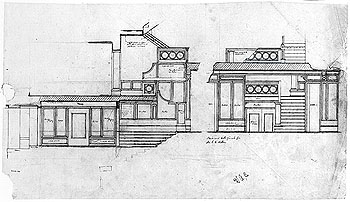 |
Date: 1899
Title:
Edward C. Waller Residence Remodeling, River Forest, IL 1899
(1899 - S.047).
Description: Two interior sections of the
Entrance and upper hall of Frank Lloyd Wright’s alterations to
the Waller Residence in 1899. Edward C. Waller was a successful
Chicago Businessman, real estate developer and an early client
and patron of Frank Lloyd Wright. In the In the entrance hall
stairway, Wright incorporates circular design elements into the
railing baluster. Similar in design to the Charles E. Roberts
House, Oak park (1896 - S.40). Robert’s windows and skylight
were published in
The Architectural Review, June 1900,
p.62, lower right, and in
Light Screens, Sloan, 2001,
p.124-125. Another important design element that was designed by
Wright was the
copper urn. There were
three in the Waller
House, two in the dining room and one in the entrance. Text
lower right: "Alterations in the Residence of Mr. E. C. Waller,
River Forest. Frank Lloyd Wright, Architect. February, 1899."
Text hand written lower left: "9901.06." Courtesy of the Frank
Lloyd Wight Foundation Archives. See
additional details...
Size:
10.5 x 6 B&W photograph.
S#:
0036.14.0521 |
|
|
|
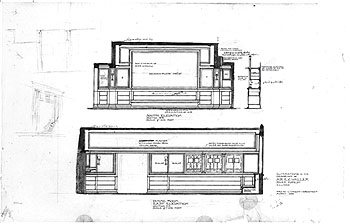 |
Date: 1899
Title:
Edward C. Waller Residence Remodeling, River Forest, IL 1899
(1899 - S.047).
Description: South and East Elevations of
the Waller Dining Room of Frank Lloyd Wright’s alterations to
the Waller Residence in 1899. Edward C. Waller was a successful
Chicago Businessman, real estate developer and an early client
and patron of Frank Lloyd Wright. Upper illustration: "South
Elevation." The built-in "Window Seat" ran the full length of
the large window and allowed Wright to hide the Radiator. The
Dining Room floor plans (9902.08) include the built-in Window
Seat. Lower illustration: "Dining Room East Elevation." To the
left of the South Elevation is the East Elevation. Existing
photographs indicate that the art glass windows were never
completed. Text lower right: "Alterations in the Residence of
Mr. E. C. Waller, River Forest. Frank Lloyd Wright, Architect.
March, 1899." Text hand written lower left: "9901.11." Courtesy
of the Frank Lloyd Wight Foundation Archives.
See additional details...
Size:
10.5 x 6 B&W photograph.
S#:
0036.15.0521 |
|
|
|
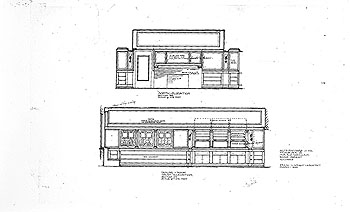 |
Date: 1899
Title:
Edward C. Waller Residence Remodeling, River Forest, IL 1899
(1899 - S.047).
Description: North and West Elevations of
the Waller Dining Room of Frank Lloyd Wright’s alterations to
the Waller Residence in 1899. Edward C. Waller was a successful
Chicago Businessman, real estate developer and an early client
and patron of Frank Lloyd Wright. Upper illustration: "North
Elevation." The North Elevation included the fireplace as well
as built-in shelves above the fireplace behind glass doors.
Lower illustration: "Dining Room West Elevation." To the left of
the North Elevation is the West Elevation. Existing photographs
indicate that the art glass windows were never completed. Text
lower right: "Alterations in the Residence of Mr. E. C. Waller,
River Forest. Frank Lloyd Wright, Architect. March, 1899." Text
hand written lower left: "9901.12." Courtesy of the Frank Lloyd
Wight Foundation Archives. See
additional details...
Size:
10.5 x 6 B&W photograph.
S#:
0036.16.0521 |
|
|
|
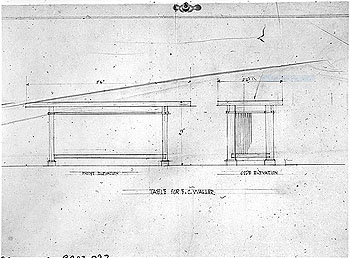 |
Date: 1899
Title:
Edward C. Waller Residence Remodeling, River Forest, IL 1899
(1899 - S.047).
Description: Table design for the E. C.
Waller Residence in 1899. Possible for the library. Edward C.
Waller was a successful Chicago Businessman, real estate
developer and an early client and patron of Frank Lloyd Wright.
Front and side elevations. Like the Dining Room table, these
legs are square and flared at the bottom. Wright also designed
the dining room table, and according to Carla Lind,
Lost Wright, 1996, p.49, Wright also designed the dining room
chairs. This table measures 56" long, 2' 2" wide, and 2' 2"
high. Courtesy of the Frank Lloyd Wight Foundation Archives.
See additional details...
Size:
10.5 x 6 B&W photograph.
S#:
0036.17.0521 |
|
|
|
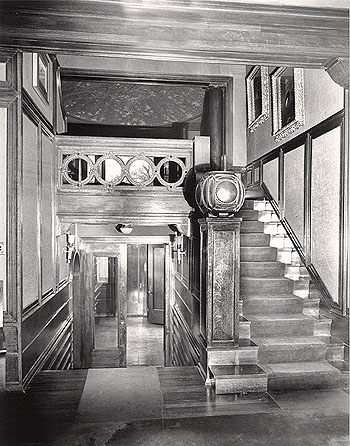 |
Date:
Circa
1900
Title:
Edward C. Waller Residence Remodeling, River Forest, IL Circa
1900 (1899 - S.047).
Description: View of the Entrance and upper hall
of Frank Lloyd Wright’s alterations to the Waller Residence.
Edward C. Waller was a successful Chicago Businessman, real
estate developer and an early client and patron of Frank Lloyd
Wright. In the entrance hall stairway, Wright incorporates
circular design elements into the railing baluster. Similar in
design to the Charles E. Roberts House, Oak park (1896 - S.40).
Robert’s windows and skylight were published in
The
Architectural Review, June 1900, p.62, lower right, and
in Light Screens,
Sloan, 2001, p.124-125. Above the Entry Hall on the second floor
is an art glass dome which appears to have a forest scene, as if
you are looking up from the forest bed to the tops of the trees
in the forest. Another important design element that was
designed by Wright was the
copper urn setting atop the newel post. There were three
in the Waller House, two in the dining room and one in the
entrance. Frank Lloyd Wright’s original drawing for the urn is
published in
Drawings for a Living Architecture, 1959, p.238. See
additional details...
Size:
8 x 10 B&W photograph.
S#:
0041.39.0621 |
|
|
|
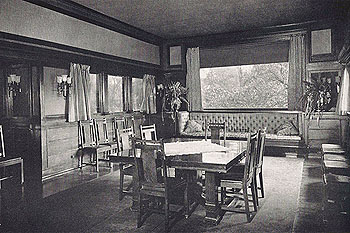 |
Date:
Circa
1900
Title:
Edward C. Waller Residence Remodeling, River Forest, IL Circa
1900 (1899 - S.047).
Description: View of the Dining Room from the
North, of Frank Lloyd Wright’s alterations to the Waller
Residence. Edward C. Waller was a successful Chicago
Businessman, real estate developer and an early client and
patron of Frank Lloyd Wright. The built-in "Window Seat" ran the
full length of the large window and allowed Wright to hide the
Radiator. The dining room table was designed by Frank Lloyd
Wright, and according to Carla Lind,
Lost Wright,
1996, p.49, Wright also designed the dining room chairs. Wright
designed art glass windows for the dining room, but there is no
evidence that they were ever executed. Two copper Urns are
placed symmetrically in the Dining Room, one on either side of
the large window. A similar photograph was published in
"Architectural Review" June 1900, p.63. There were
three Urns in the Waller
House, two in the dining room and one in the entrance. Frank
Lloyd Wright’s original drawing for the urn is published in
Drawings for a
Living Architecture, 1959, p.238.
See
additional details... See
additional Wright Chairs...
Size:
10 x 6.75 B&W photograph.
S#:
0041.40.0621 |
|
|
|
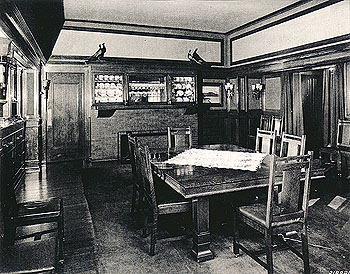 |
Date:
Circa
1900
Title:
Edward C. Waller Residence Remodeling, River Forest, IL Circa
1900 (1899 - S.047).
Description: View of the Dining Room from the
South, of Frank Lloyd Wright’s alterations to the Waller
Residence. Edward C. Waller was a successful Chicago
Businessman, real estate developer and an early client and
patron of Frank Lloyd Wright. The dining room table was designed
by Frank Lloyd Wright, and according to Carla Lind,
Lost Wright,
1996, p.49, Wright also designed the dining room chairs. The
fireplace is in the background on the North side of the dining
room, with built-in shelves above the fireplace behind glass
doors. Text lower right: "218891." Copy photograph of image
published in Frank Lloyd Wright
Interiors and Furniture, Heinz, 1994, p.30. Courtesy of
the Frank Lloyd Wright Foundation. See
additional details... See
additional Wright Chairs...
Size:
10 x 8 B&W photograph.
S#:
0041.41.0621 |
|
|
|
|
|
|
|
|
|
|
EDWARD C. WALLER STABLE & POULTRY HOUSE (1901 - S.066) |
|
|
|
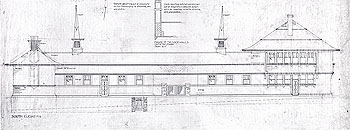 |
Date:
1901
Title:
Edward C. Waller Stable & Poultry House, River Forest, IL (1901
- S.066).
Description: South Elevation for the Mr. Edward
C. Waller Stables, South Elevation. November 3, 1901. Sheet 3.
Designed by Frank Lloyd Wright in 1901. On Sheet 1, the floor
plan for the first floor, the left side was used for Ice
Storage, Cows and Tools and a Storage Area. There is a passage
way though the gates in the center. The right side held stalls
for horses, harness room, Coachman’s room (office?), and a large
section for carriages. On Sheet 2, the floor plan for the second
floor includes a two-bedroom, one-bath apartment, with a living
room and kitchen. About a third of it is used for a hay loft.
The two spire "ventilators" are covered in copper and shingles.
Courtesy of the Frank Lloyd Wight Foundation.
See additional details...
Size:
10.5 x 4 B&W photograph.
S#:
0049.20.0521 |
|
|
|
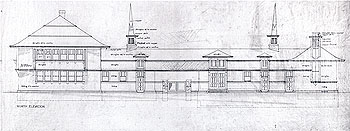 |
Date:
1901
Title:
Edward C. Waller Stable & Poultry House, River Forest, IL (1901
- S.066).
Description: North Elevation for the Mr. Edward
C. Waller Stables, North Elevation. November 3, 1901. Sheet 4.
Designed by Frank Lloyd Wright in 1901. On Sheet 1, the floor
plan for the first floor, the left side held a Coachman’s room
(office?), and a large section for carriages, harness room and
stalls for horses. There is a passage way though the gates in
the center. The right side held a Storage Area, Tools and cows,
and Ice Storage. On Sheet 2, the floor plan for the second floor
includes a two-bedroom, one-bath apartment, with a living room
and kitchen. About a third of it is used for a hay loft. The two
spire "ventilators" are covered in copper and shingles. Courtesy
of the Frank Lloyd Wight Foundation.
See additional details...
Size:
10.5 x 4 B&W photograph.
S#:
0049.21.0521 |
|
|
|
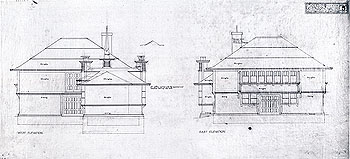 |
Date:
1901
Title:
Edward C. Waller Stable & Poultry House, River Forest, IL (1901
- S.066).
Description: West (left) and East
(right) Elevations for the Mr. Edward C. Waller Stables, West
and East Elevation. November 3, 1901. Sheet 5. Designed by Frank
Lloyd Wright in 1901. On Sheet 1, the floor plan for the first
floor of the two-story section, held the harness room,
Coachman’s room (office?), and a large section for carriages. On
Sheet 2, the floor plan for the second floor includes a
two-bedroom, one-bath apartment, with a living room and kitchen.
About a third of it is used for a hay loft. The two spire
"ventilators" are covered in copper and shingles. Courtesy of
the Frank Lloyd Wight Foundation.
See additional details...
Size:
10.5 x 4.75 B&W photograph.
S#:
0049.22.0521 |
|
|
|
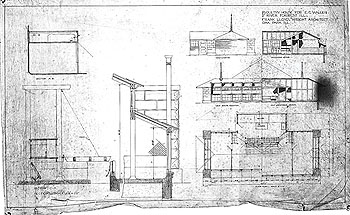 |
Date:
1901
Title:
Edward C. Waller Stable & Poultry House, River Forest, IL (1901
- S.066).
Description: West and South Elevation for the Mr.
Edward C. Waller Poultry House. Text top right: "Poultry House
for E. C. Waller, River Forest, ILL. Frank Lloyd Wright,
Architect, Oak Park." Designed by Frank Lloyd Wright in 1901.
The West Elevation is pictured in the photograph by Gilman Lane.
The Poultry House appears to be added on to an existing barn to
the North. The two spire "ventilators" are similar to those
Wright added to the Stables. Text lower left: "0108.03."
Courtesy of the Frank Lloyd Wight Foundation.
See additional details...
Size:
10 x 6.5 B&W photograph.
S#:
0049.23.0521 |
|
|
|
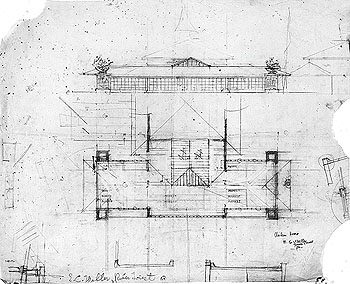 |
Date:
1901
Title:
Edward C. Waller Stable & Poultry House, River Forest, IL (1901
- S.066).
Description: Alternative design of the South
Elevation and Floor Plan for the Mr. Edward C. Waller Poultry
House. Hand written lower right: "Chicken House." Designed by
Frank Lloyd Wright in 1901. This variation removes the spires,
but adds large urns. In the background Wright lightly penciled
in the existing barn with its tower. Text lower left: "0108.02.
E. C. Waller, River Forest." Courtesy of the Frank Lloyd Wight
Foundation.
See additional details...
Size:
10 x 8 B&W photograph.
S#:
0049.24.0521 |
|
|
|
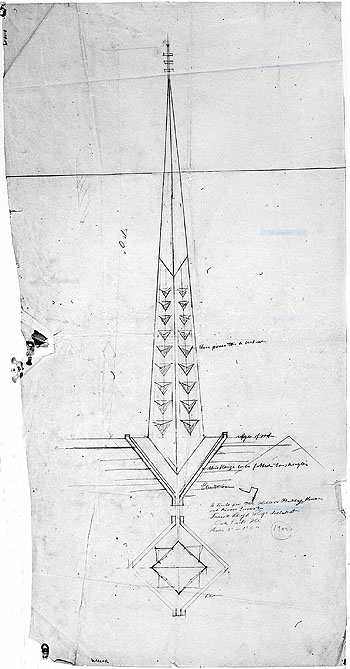 |
Date:
1901
Title:
Edward C. Waller Stable & Poultry House, River Forest, IL (1901
- S.066).
Description: Detail of the Spire "Ventilator" for
the Mr. Edward C. Waller Poultry House. Designed by Frank Lloyd
Wright in 1901. Wright does not specify materials for finishing
this spire, but on the stables he specified copper and shingles.
Hand written top left: "0108.09." Hand written to the right of
the spire: "These pieces to be bent out." Hand written at the
base of the spire: "Ridge of roof. This flange to be fitted to
shingles. Elevation. 2 vents for Mr. Waller’s Poultry House at
River Forest. Frank Lloyd Wright Architect. Oak Park, IL."
Courtesy of the Frank Lloyd Wight Foundation.
See additional details...
Size:
5.5 x 10 B&W photograph.
S#:
0049.25.0521 |
|
|
|
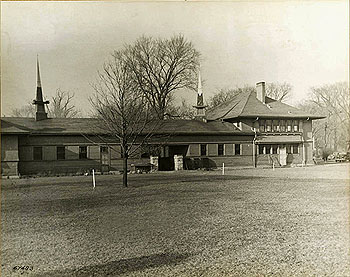 |
Date:
Circa 1935-40
Title:
Edward C. Waller Stables, South Elevation, River Forest, IL
Circa 1935-1945 (1901 - S.066).
Description: South Elevation of the Mr. Edward C.
Waller Stables. Designed by Frank Lloyd Wright in 1901. On Sheet
1 of the original floor plan for the first floor, the left side
was used for Ice Storage, Cows and Tools and a Storage Area.
There is a passage way though the gates in the center. The right
side held stalls for horses, harness room, Coachman’s room
(office?), and a large section for carriages. On Sheet 2, the
floor plan for the second floor includes a two-bedroom, one-bath
apartment, with a living room and kitchen. About a third of it
is used for a hay loft. The two spire "ventilators" are covered
in copper and shingles. The interior of the Edward C. Waller
home, was remodeled by Frank Lloyd Wright in 1899, and
demolished in 1939. All other structures on the estate except
the Waller Gates were also demolished. Text bottom left:
"67483." Photographed by Gilman Lane. Courtesy of the Art
Institute of Chicago.
See additional details...
Size:
10 x 8 B&W photograph.
S#:
0397.72.0521 |
|
|
|
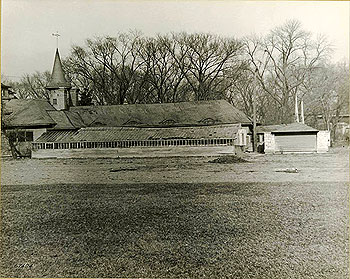 |
Date:
Circa 1935-40
Title:
Edward C. Waller Poultry House, West Elevation, River Forest, IL
Circa 1935-1945 (1901 - S.066).
Description: West Elevation of the Edward C.
Waller Poultry House. Designed by Frank Lloyd Wright in 1901.
The Poultry House is the smaller building on the far right and
measured 20' x 50'. It is attached to the end of an existing
bard and what appears to be a glass nursery. Like the Waller
Gates, the four corners are stone piers. Like the Stables, there
are two decorative spire "ventilators." The interior of the
Edward C. Waller home, was remodeled by Frank Lloyd Wright in
1899, and demolished in 1939. All other structures on the estate
except the Waller Gates were also demolished. Text bottom left:
"67484." Photographed by Gilman Lane. Courtesy of the Art
Institute of Chicago.
See additional details...
Size:
10 x 8 B&W photograph.
S#:
0397.73.0521 |
|
|
|
|
|
|
|
|
|
|
EDWARD C. WALLER GATES (1901 - S.065) |
|
|
|
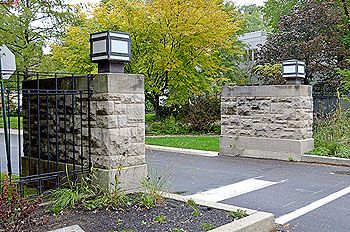 |
Date:
2018
Title:
Edward C. Waller Gates, River Forest, IL (1901 - S.065).
Description: Set of 25 photographs of the Waller
Gates. Designed by Frank Lloyd Wright in 1901. Edward C. Waller
was a successful Chicago Businessman, real estate developer and
an early client and patron of Frank Lloyd Wright. Waller
developed the Home Insurance Building at the corner of LaSalle
and Adams Streets in 1885. In 1888 Waller built the Rookery
Building on the opposite corner of La Salle and Adams Streets.
In 1893-4, Waller sold a lot across the street from his own
house to William Winslow (1894 - S.24), who commissioned Wright
to design his home. In 1895...
Continue...
Size:
Set of 25 high res 20 X
13.5 digital images.
S#:
2018.34.0521 (1-25) |
|
|
|
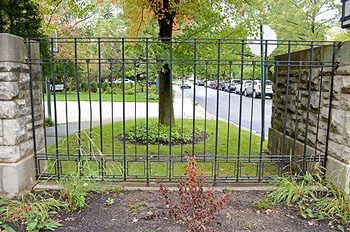 |
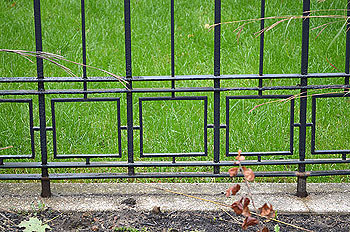 |
|
|
|
 |
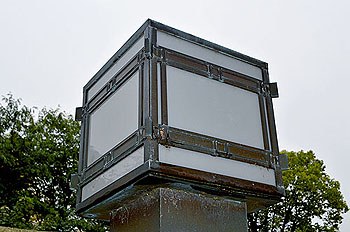 |
|
|
|
|
|
|
|
|
|
|
EDWARD C. WALLER BATHING PAVILION (1909 - S.166) |
|
|
|
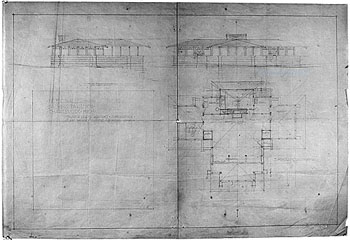 |
Date:
1909
Title:
Edward C. Waller Bathing Pavilion, Charlevoix, Michigan,
Elevation and Plan 1909 (1909 - S.166).
Description: Side and Front Elevations, Floor
Plan. Windows run the entire periphery of the pavilion. Designed
by Frank Lloyd Wright in 1909. Text center left: "Mr. E. C.
Waller. Bathing Pavilion. Charlevoix, Mich. Frank Lloyd Wright,
Architect. Oak Park, Illinois. June 10, 1909." Hand written
lower left: "0916.01." Edward C. Waller was a successful Chicago
Businessman, real estate developer and an early client and
patron of Frank Lloyd Wright. One of his projects was a 2,000
acre parcel of land on Lake Michigan, just north of Charlevoix,
and ran half way Petosky. Immediately North of Charlevoix there
is still a Road named Waller that runs a little over half a
mile. In 1902 Wright created two designs for a large summer
house on the property (FLLW #0212 and #0310). Neither was built.
In 1909 Wright designed a Bathing (swimming) Pavilion on the
property. Located on the beach, it provided a large common area
with fireplace, separate bath/changing room and lounge for men
and women. Behind the fireplace was a kitchen. The front of the
building had a large veranda, balance on either side by large
concrete urns. It was demolished in 1922-23 by fire. Courtesy of
the Frank Lloyd Wight Foundation.
See additional details...
Size:
10 x 6.75 B&W photograph.
S#:
0086.30.0521 |
|
|
|
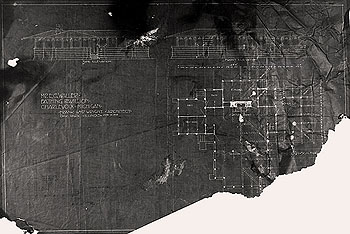 |
Date:
1909
Title:
Edward C. Waller Bathing Pavilion, Charlevoix, Michigan,
Elevation and partial Plan 1909 (1909 - S.166).
Description: Side and Front Elevations, partial
Floor Plan. Windows run the entire periphery of the pavilion.
Designed by Frank Lloyd Wright in 1909. This plan appears to
have enlarged the building. Stairs and a doorway were added on
both sides, leading to the common area. The veranda also appears
to be enlarged. Wright may have presented both versions at the
same time. Comparing the plans to the photograph, it appears
this is the plan that was chosen. Text center left: "Mr. E. C.
Waller. Bathing Pavilion. Charlevoix, Mich. Frank Lloyd Wright,
Architect. Oak Park, Illinois. June 10, 1909." Edward C. Waller
was a successful Chicago Businessman, real estate developer and
an early client and patron of Frank Lloyd Wright. One of his
projects was a 2,000 acre parcel of land on Lake Michigan, just
north of Charlevoix, and ran half way Petosky. Immediately North
of Charlevoix there is still a Road named Waller that runs a
little over half a mile. In 1902 Wright created two designs for
a large summer house on the property (FLLW #0212 and #0310).
Neither was built. In 1909 Wright designed a Bathing (swimming)
Pavilion on the property. Located on the beach, it provided a
large common area with fireplace, separate bath/changing room
and lounge for men and women. Behind the fireplace was a
kitchen. The front of the building had a large veranda, balance
on either side by large concrete urns. It was demolished in
1922-23 by fire. Courtesy of the Frank Lloyd Wight Foundation.
See additional details...
Size:
10 x 6.75 B&W photograph.
S#:
0086.31.0521 |
|
|
|
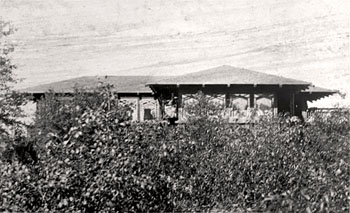 |
Date:
1910
Title:
Edward C. Waller Bathing Pavilion, Charlevoix, Michigan Circa
1910 - Not Dated (1909 - S.166).
Description: View of the side of the Pavilion.
The front is on the left, back is to the right. Windows run the
entire periphery of the pavilion. Designed by Frank Lloyd Wright
in 1909. Edward C. Waller was a successful Chicago Businessman,
real estate developer and an early client and patron of Frank
Lloyd Wright. One of his projects was a 2,000 acre parcel of
land on Lake Michigan, just north of Charlevoix, and ran half
way Petosky. Immediately North of Charlevoix there is still a
Road named Waller that runs a little over half a mile. In 1902
Wright created two designs for a large summer house on the
property (FLLW #0212 and #0310). Neither was built. In 1909
Wright designed a Bathing (swimming) Pavilion on the property.
Located on the beach, it provided a large common area with
fireplace, separate bath/changing room and lounge for men and
women. Behind the fireplace was a kitchen. The front of the
building had a large veranda, balance on either side by large
concrete urns. This photograph appears to be the only one that
has survived. It was demolished in 1922-23 by fire.
See additional details...
Size:
10 x 6.5 B&W photograph.
S#:
0094.92.0521 |
| |
|
|
|
|
|
|
|
|
|
EDWARD C. WALLER HOUSE REMODELING DETAILS (1899) |
|
|
|
|
EXTERIOR ELEVATION
ENTRANCE SECTION SOUTH
& EAST ELEVATIONS NORTH
& WEST ELEVATIONS TABLE |
|
|
|
|
WALLER EXTERIOR ELEVATION |
| |
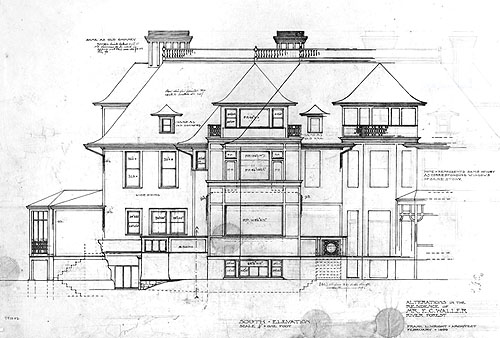 |
|
1)
Edward C. Waller Residence Remodeling, River Forest, IL 1899
(1899 - S.047).
South Elevation of Frank Lloyd Wright’s alterations to the
Waller Residence in 1899. Architect Daniel Burnham, Burnham
and Root, designed the original Waller House. It was
demolished in 1939. According to Lind, Wright’s changes
included an "octagonal party pavilion with a glass
passageway that joined it to the house." Wright also
extended the dining room as well as a kitchen wing with
bedrooms above. Wright’s design for the interior was
extensive as well, including designed built-ins and
furniture. Text lower right:
"Alterations in the Residence of Mr. E. C. Waller, River Forest.
Frank Lloyd Wright, Architect. February, 1899." Text hand
written lower left: "9901.02." Courtesy of the Frank Lloyd Wight
Foundation Archives. (S#0036.13.0521) |
| |
|
|
|
| |
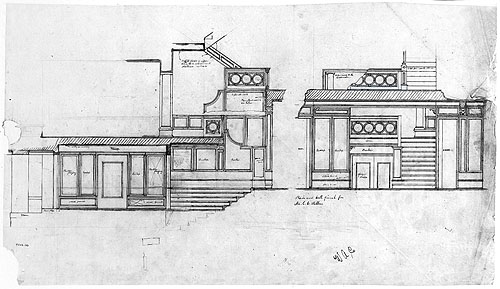 |
| 2)
Edward C. Waller Residence Remodeling, River Forest, IL 1899
(1899 - S.047).
Two interior sections of the
Entrance and upper hall of Frank Lloyd Wright’s alterations to
the Waller Residence in 1899. Edward C. Waller was a successful
Chicago Businessman, real estate developer and an early client
and patron of Frank Lloyd Wright. In the In the entrance hall
stairway, Wright incorporates circular design elements into the
railing baluster. Similar in design to the Charles E. Roberts
House, Oak park (1896 - S.40). Robert’s windows and skylight
were published in
The Architectural Review, June 1900,
p.62, lower right, and in
Light Screens, Sloan, 2001,
p.124-125. Another important design element that was designed by
Wright was the
copper urn. There were three in the Waller
House, two in the dining room and one in the entrance. Text
lower right: "Alterations in the Residence of Mr. E. C. Waller,
River Forest. Frank Lloyd Wright, Architect. February, 1899."
Text hand written lower left: "9901.06." Courtesy of the Frank
Lloyd Wight Foundation Archives. (S#0036.14.0521) |
| |
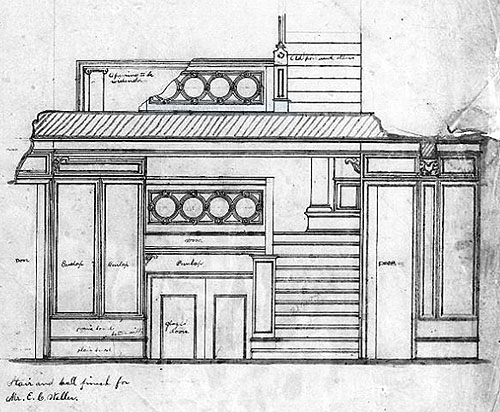 |
|
2A) Detail of the
entrance and upper hall of Frank Lloyd Wright’s alterations
to the Waller Residence in 1899. |
|
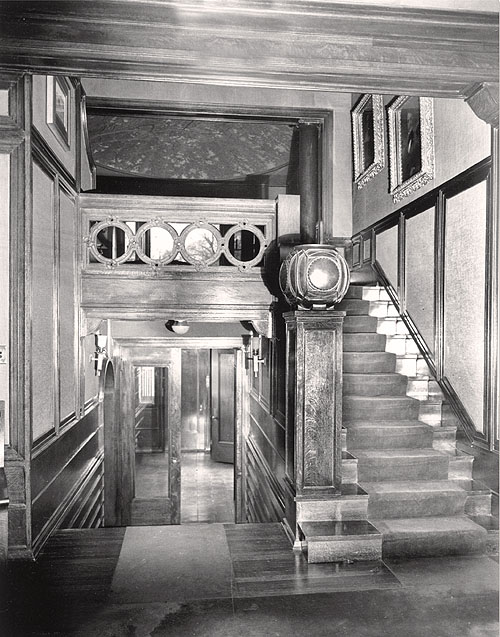 |
|
3) Edward C. Waller Residence
Remodeling, River Forest, IL Circa 1900 (1899 - S.047). View
of the Entrance and upper hall of Frank Lloyd Wright’s
alterations to the Waller Residence. Edward C. Waller was a
successful Chicago Businessman, real estate developer and an
early client and patron of Frank Lloyd Wright. In the
entrance hall stairway, Wright incorporates circular design
elements into the railing baluster. Similar in design to the
Charles E. Roberts House, Oak park (1896 - S.40). Robert’s
windows and skylight were published in
The
Architectural Review, June 1900, p.62, lower right,
and in Light Screens,
Sloan, 2001, p.124-125. Above the Entry Hall on the second
floor is an art glass dome which appears to have a forest
scene, as if you are looking up from the forest bed to the
tops of the trees in the forest. Another important design
element that was designed by Wright was the
copper urn setting
atop the newel post. There were three in the Waller House,
two in the dining room and one in the entrance. Frank Lloyd
Wright’s original drawing for the urn is published in
Drawings for a
Living Architecture, 1959, p.238. (S#0041.39.0621) |
|
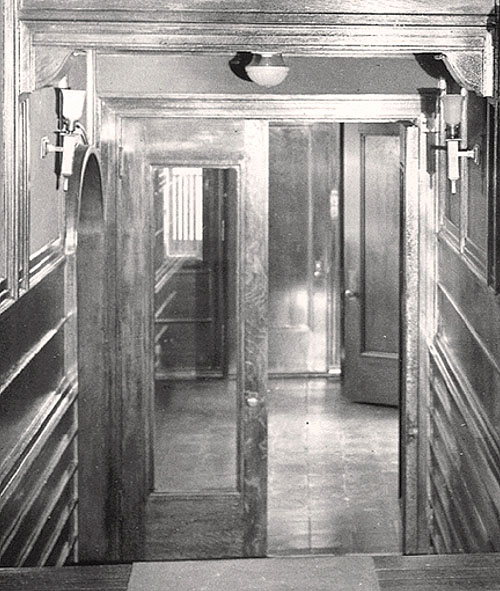 |
|
3A) Detail of the Edward C. Waller
Residence Remodeling Entrance hall. |
|
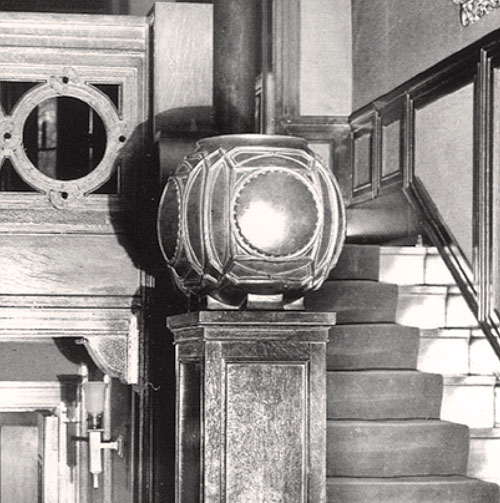 |
|
3B) Detail of the Edward C. Waller
Residence Remodeling
copper urn setting atop the newel post. |
| |
 |
|
3C) Detail of the Edward C. Waller
Residence Remodeling circular design elements in the railing
baluster. |
| |
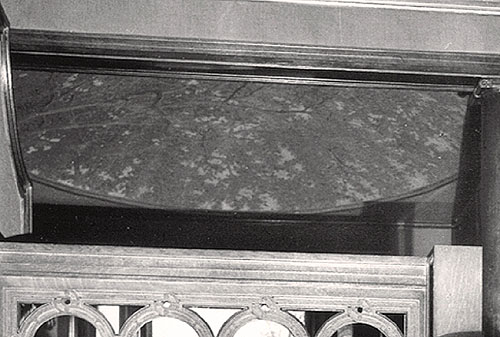 |
|
3D) Detail of the Edward C. Waller
Residence Remodeling art glass dome which appears to have a
forest scene, as if you are looking up from the forest bed
to the tops of the trees in the forest.
|
|
| |
|
|
| |
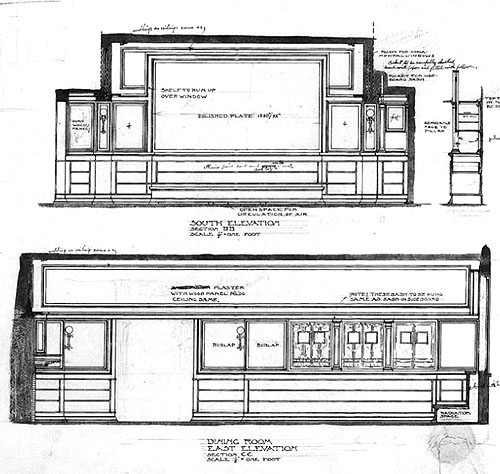 |
|
4)
Edward C. Waller Residence Remodeling, River Forest, IL 1899
(1899 - S.047).
South and East Elevations of
the Waller Dining Room of Frank Lloyd Wright’s alterations to
the Waller Residence in 1899. Edward C. Waller was a successful
Chicago Businessman, real estate developer and an early client
and patron of Frank Lloyd Wright. Upper illustration: "South
Elevation." The built-in "Window Seat" ran the full length of
the large window and allowed Wright to hide the Radiator. The
Dining Room floor plans (9902.08) include the built-in Window
Seat. Lower illustration: "Dining Room East Elevation." To the
left of the South Elevation is the East Elevation. Existing
photographs indicate that the art glass windows were never
completed. Text lower right: "Alterations in the Residence of
Mr. E. C. Waller, River Forest. Frank Lloyd Wright, Architect.
March, 1899." Text hand written lower left: "9901.11."
(S#0036.15.0521) |
| |
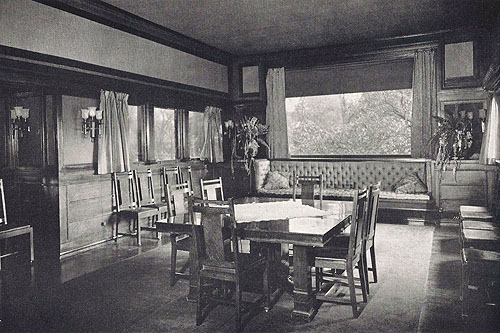 |
|
5) Edward C. Waller Residence
Remodeling, River Forest, IL Circa 1900 (1899 - S.047). View
of the Dining Room from the North, of Frank Lloyd Wright’s
alterations to the Waller Residence. Edward C. Waller was a
successful Chicago Businessman, real estate developer and an
early client and patron of Frank Lloyd Wright. The built-in
"Window Seat" ran the full length of the large window and
allowed Wright to hide the Radiator. The dining room table
was designed by Frank Lloyd Wright, and according to Carla
Lind, Lost Wright,
1996, p.49, Wright also designed the dining room chairs.
Wright designed art glass windows for the dining room, but
there is no evidence that they were ever executed. Two
copper Urns are placed symmetrically in the Dining Room, one
on either side of the large window. A similar photograph was
published in "Architectural Review" June 1900, p63. There
were three Urns in the
Waller House, two in the dining room and one in the
entrance. Frank Lloyd Wright’s original drawing for the urn
is published in
Drawings for a
Living Architecture, 1959, p.238. (S#0041.40.0621) |
|
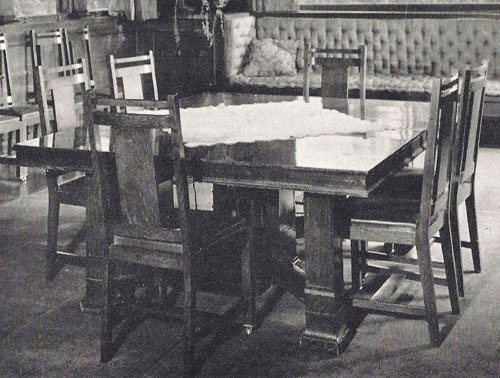 |
|
5A) Detail
of the Edward C. Waller Residence Remodeling Dining Room
Table and Chairs designed by Frank Lloyd Wright.
|
|
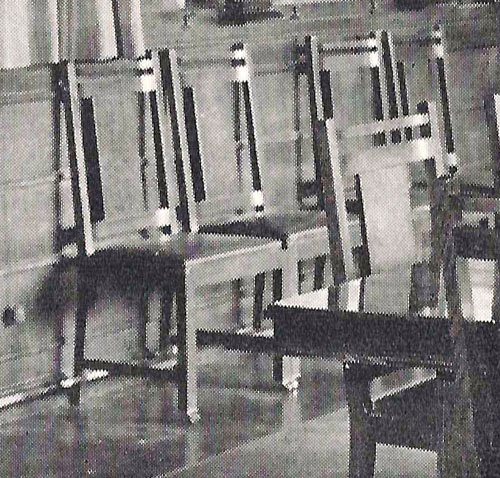 |
|
5B) Detail
of the Edward C. Waller Residence Remodeling Dining Room
Table and Chairs designed by Frank Lloyd Wright.
|
| |
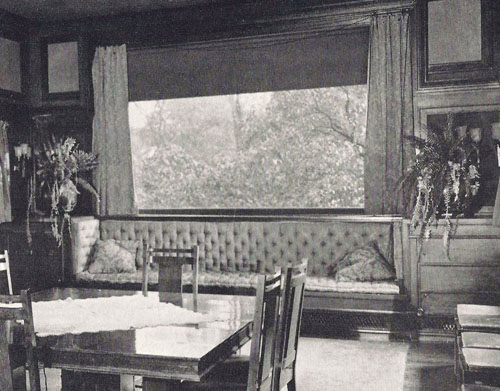 |
|
5C) Detail
of the Edward C. Waller Residence Remodeling Dining Room.
The built-in "Window Seat" ran the full length of the large
window and allowed Wright to hide the Radiator. The dining
room table was designed by Frank Lloyd Wright, and according
to Carla Lind,
Lost Wright, 1996, p.49, Wright also designed the
dining room chairs. Two copper Urns are placed symmetrically
in the Dining Room, one on either side of the large window.
A similar photograph was published in "Architectural Review"
June 1900, p63. There were
three Urns in the Waller House, two in the dining room
and one in the entrance.
|
| |
| |
|
|
| |
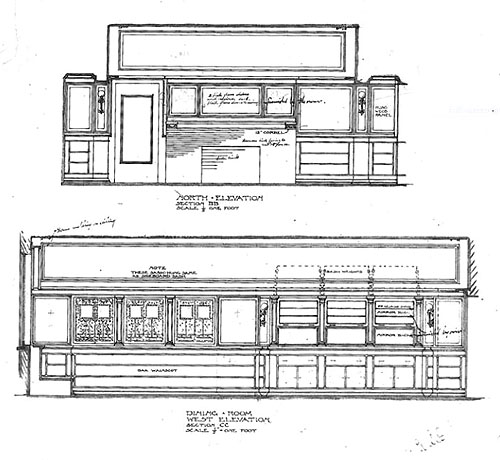 |
|
6)
Edward C. Waller Residence Remodeling, River Forest, IL 1899
(1899 - S.047).
North and West Elevations of the Waller Dining Room of Frank
Lloyd Wright’s alterations to the Waller Residence in 1899.
Edward C. Waller was a successful Chicago Businessman, real
estate developer and an early client and patron of Frank
Lloyd Wright. Upper illustration: "North Elevation." The
North Elevation included the fireplace as well as built-in
shelves above the fireplace behind glass doors. Lower
illustration: "Dining Room West Elevation." To the left of
the North Elevation is the West Elevation. Existing
photographs indicate that the art glass windows were never
completed. Text lower right: "Alterations in the Residence
of Mr. E. C. Waller, River Forest. Frank Lloyd Wright,
Architect. March, 1899." Text hand written lower left:
"9901.12." Courtesy of the Frank Lloyd Wight Foundation
Archives. (S#0036.16.0521) |
| |
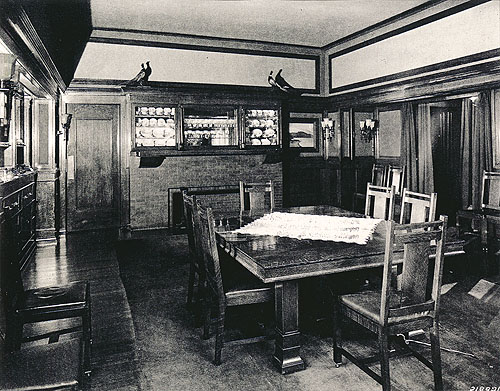 |
|
7) Edward C. Waller Residence
Remodeling, River Forest, IL Circa 1900 (1899 - S.047). View
of the Dining Room from the South, of Frank Lloyd Wright’s
alterations to the Waller Residence. Edward C. Waller was a
successful Chicago Businessman, real estate developer and an
early client and patron of Frank Lloyd Wright. The dining
room table was designed by Frank Lloyd Wright, and according
to Carla Lind,
Lost Wright, 1996, p.49, Wright also designed the
dining room chairs. The fireplace is in the background on
the North side of the dining room, with built-in shelves
above the fireplace behind glass doors. Text lower right:
"218891." Copy photograph of image published in
Frank Lloyd Wright Interiors
and Furniture, Heinz, 1994, p.30. Courtesy of the
Frank Lloyd Wright Foundation. (S#0041.41.0621) |
|
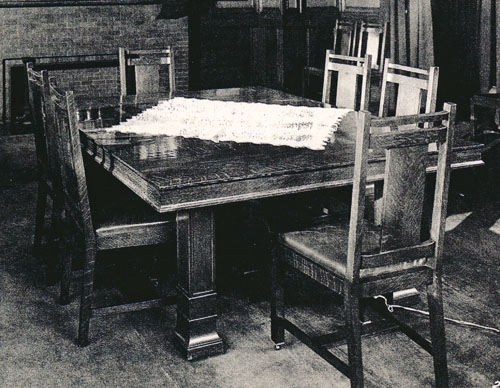 |
|
7A) Detail of the Edward C. Waller
Residence Remodeling, Dining Room table and chairs. |
| |
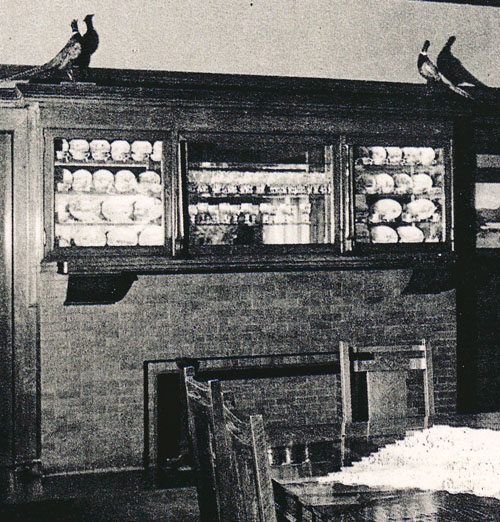 |
|
7B) Detail of the Edward C. Waller
Residence Remodeling, Fireplace and built-in shelves. |
| |
| |
|
|
| |
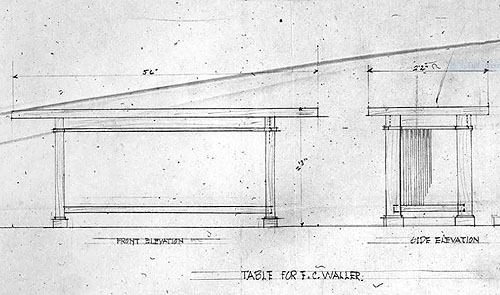 |
|
|
8)
Edward C. Waller Residence Remodeling, River Forest, IL 1899
(1899 - S.047).
Table design for the E. C.
Waller Residence in 1899. Possible for the library. Edward C.
Waller was a successful Chicago Businessman, real estate
developer and an early client and patron of Frank Lloyd Wright.
Front and side elevations. Like the Dining Room table, these
legs are square and flared at the bottom. Wright also designed
the dining room table, and according to Carla Lind,
Lost Wright, 1996, p.49, Wright also designed the dining room
chairs. This table measures 56" long, 2' 2" wide, and 2' 2"
high. Courtesy of the Frank Lloyd Wight Foundation Archives. (S#0036.14.0521) |
| |
| |
| |
|
|
EDWARD C. WALLER STABLE & POULTRY DETAIL (1901 - S.066) |
|
|
|
|
STABLE
POULTRY HOUSE |
|
|
WALLER STABLE |
| |
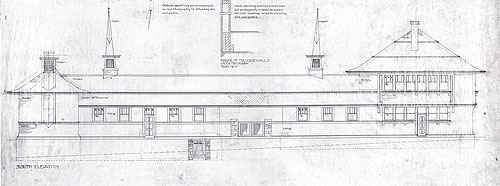 |
|
1)
Edward C. Waller Stable & Poultry House, River Forest, IL (1901
- S.066).
South Elevation for the Mr. Edward
C. Waller Stables, South Elevation. November 3, 1901. Sheet 3.
Designed by Frank Lloyd Wright in 1901. On Sheet 1, the floor
plan for the first floor, the left side was used for Ice
Storage, Cows and Tools and a Storage Area. There is a passage
way though the gates in the center. The right side held stalls
for horses, harness room, Coachman’s room (office?), and a large
section for carriages. On Sheet 2, the floor plan for the second
floor includes a two-bedroom, one-bath apartment, with a living
room and kitchen. About a third of it is used for a hay loft.
The two spire "ventilators" are covered in copper and shingles.
Courtesy of the Frank Lloyd Wight Foundation. (S#0049.20.0521) |
| |
 |
|
1A) Detail of the
South Elevation for the Mr. Edward C. Waller Stables,. |
| |
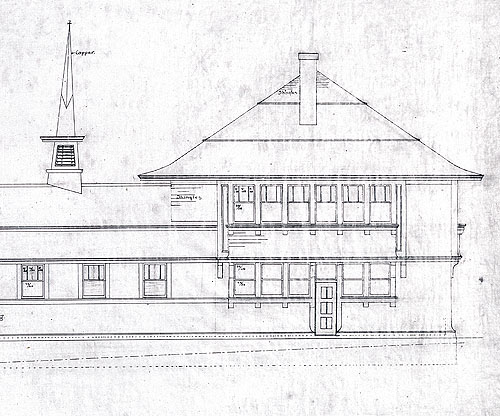 |
|
1B) Detail of the
South Elevation for the Mr. Edward C. Waller Stables,. |
| |
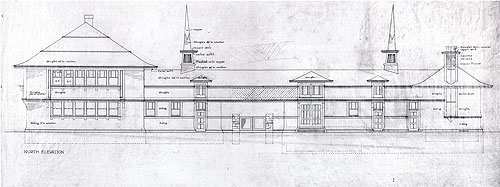 |
|
2)
Edward C. Waller Stable & Poultry House, River Forest, IL (1901
- S.066).
North Elevation for the Mr. Edward
C. Waller Stables, North Elevation. November 3, 1901. Sheet 4.
Designed by Frank Lloyd Wright in 1901. On Sheet 1, the floor
plan for the first floor, the left side held a Coachman’s room
(office?), and a large section for carriages, harness room and
stalls for horses. There is a passage way though the gates in
the center. The right side held a Storage Area, Tools and cows,
and Ice Storage. On Sheet 2, the floor plan for the second floor
includes a two-bedroom, one-bath apartment, with a living room
and kitchen. About a third of it is used for a hay loft. The two
spire "ventilators" are covered in copper and shingles. Courtesy
of the Frank Lloyd Wight Foundation. (S#0049.21.0521) |
| |
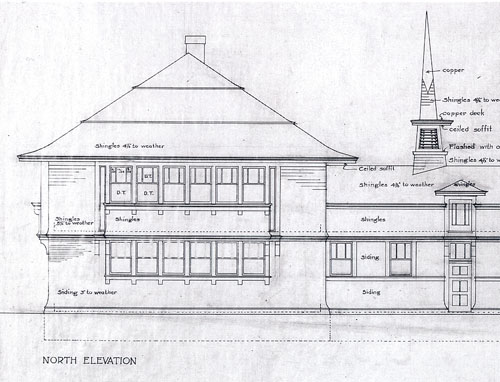 |
| 2A) Detail of the
North Elevation for the Mr. Edward C. Waller Stables,. |
| |
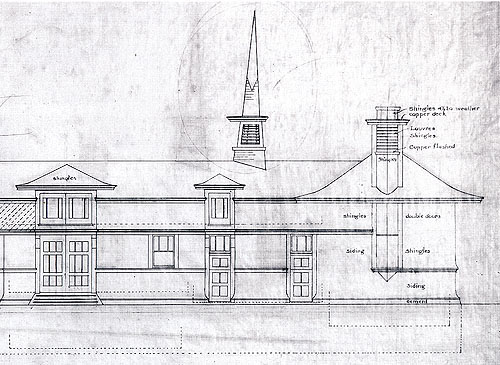 |
| 2B) Detail of the
North Elevation for the Mr. Edward C. Waller Stables,. |
| |
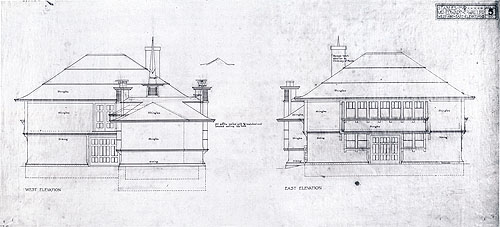 |
|
3)
Edward C. Waller Stable & Poultry House, River Forest, IL (1901
- S.066). West (left) and East
(right) Elevations for the Mr. Edward C. Waller Stables, West
and East Elevation. November 3, 1901. Sheet 5. Designed by Frank
Lloyd Wright in 1901. On Sheet 1, the floor plan for the first
floor of the two-story section, held the harness room,
Coachman’s room (office?), and a large section for carriages. On
Sheet 2, the floor plan for the second floor includes a
two-bedroom, one-bath apartment, with a living room and kitchen.
About a third of it is used for a hay loft. The two spire
"ventilators" are covered in copper and shingles. Courtesy of
the Frank Lloyd Wight Foundation. (S#0049.22.0521) |
| |
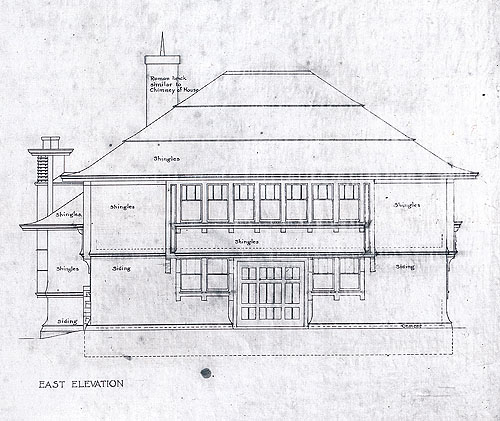 |
|
3A) Detail of the
West & East Elevation for the Mr. Edward C. Waller Stables,. |
| |
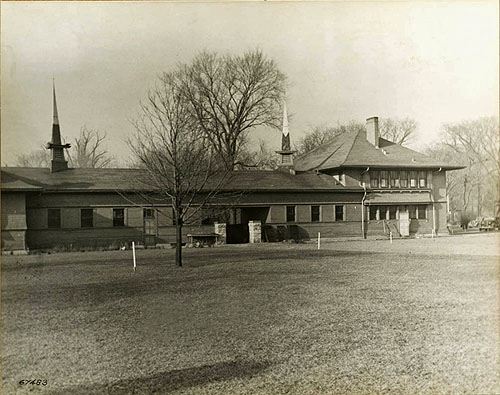 |
|
4) Edward C. Waller Stables, South
Elevation, River Forest, IL Circa 1935-1945 (1901 - S.066).
South Elevation of the Mr. Edward C. Waller Stables.
Designed by Frank Lloyd Wright in 1901. On Sheet 1 of the
original floor plan for the first floor, the left side was
used for Ice Storage, Cows and Tools and a Storage Area.
There is a passage way though the gates in the center. The
right side held stalls for horses, harness room, Coachman’s
room (office?), and a large section for carriages. On Sheet
2, the floor plan for the second floor includes a
two-bedroom, one-bath apartment, with a living room and
kitchen. About a third of it is used for a hay loft. The two
spire "ventilators" are covered in copper and shingles. The
interior of the Edward C. Waller home, was remodeled by
Frank Lloyd Wright in 1899, and demolished in 1939. All
other structures on the estate except the Waller Gates were
also demolished. Text bottom left: "67483." Photographed by
Gilman Lane. Courtesy of the Art Institute of Chicago. (S#0397.72.0521) |
| |
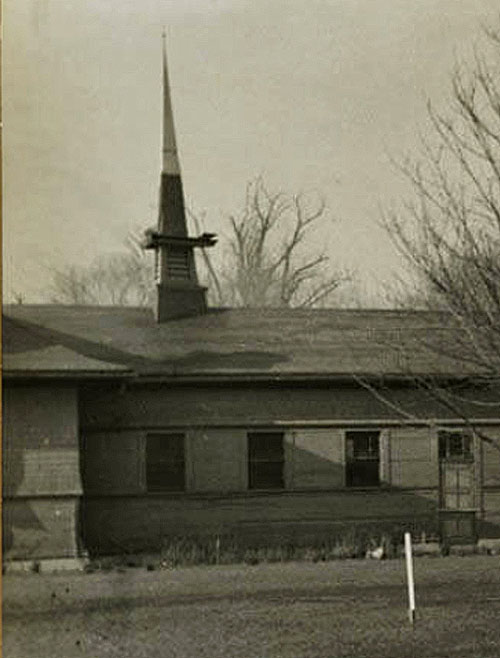 |
|
4A) Detail of the
South Elevation for the Mr. Edward C. Waller Stables. |
| |
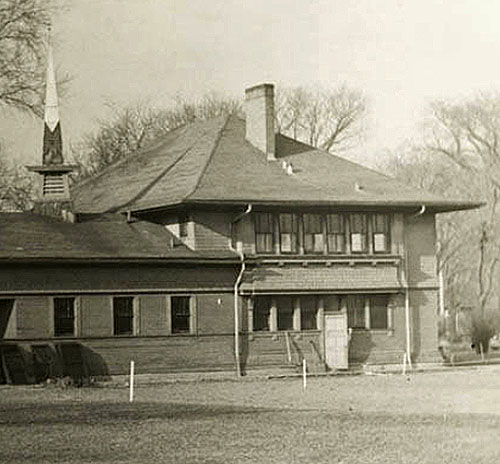 |
| 4B) Detail of the
South Elevation for the Mr. Edward C. Waller Stables. |
| |
| |
|
WALLER POULTRY
HOUSE |
| |
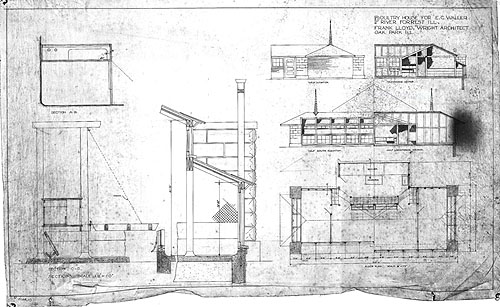 |
|
5) Edward C. Waller Stable &
Poultry House, River Forest, IL (1901 - S.066). West and
South Elevation for the Mr. Edward C. Waller Poultry House.
Text top right: "Poultry House for E. C. Waller, River
Forest, ILL. Frank Lloyd Wright, Architect, Oak Park."
Designed by Frank Lloyd Wright in 1901. The West Elevation
is pictured in the photograph by Gilman Lane. The Poultry
House appears to be added on to an existing barn to the
North. The two spire "ventilators" are similar to those
Wright added to the Stables. Text lower left: "0108.03."
Courtesy of the Frank Lloyd Wight Foundation. (S#0049.23.0521) |
| |
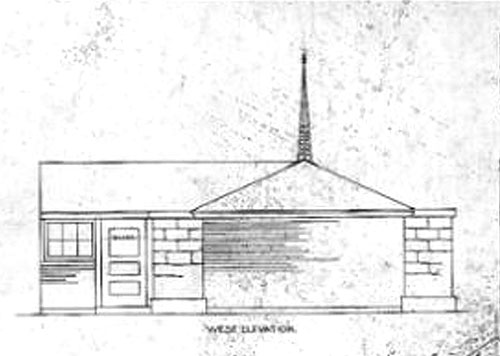 |
| 5A) Detail of the
West Elevation for the Mr. Edward C. Waller Poultry House. |
| |
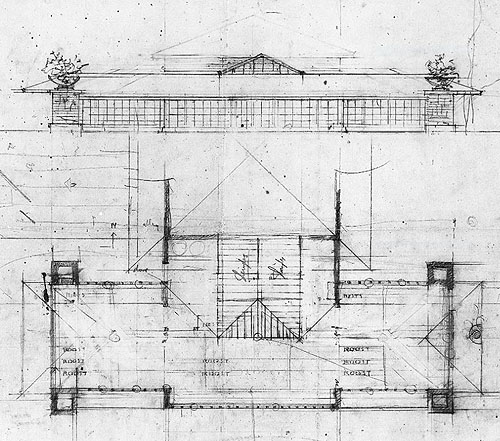 |
|
6) Edward C. Waller Stable & Poultry
House, River Forest, IL (1901 - S.066). Alternative design
of the South Elevation and Floor Plan for the Mr. Edward C.
Waller Poultry House. Hand written lower right: "Chicken
House." Designed by Frank Lloyd Wright in 1901. This
variation removes the spires, but adds large urns. In the
background Wright lightly penciled in the existing barn with
its tower. Text lower left: "0108.02. E. C. Waller, River
Forest." Courtesy of the Frank Lloyd Wight Foundation. (S#0049.24.0521) |
| |
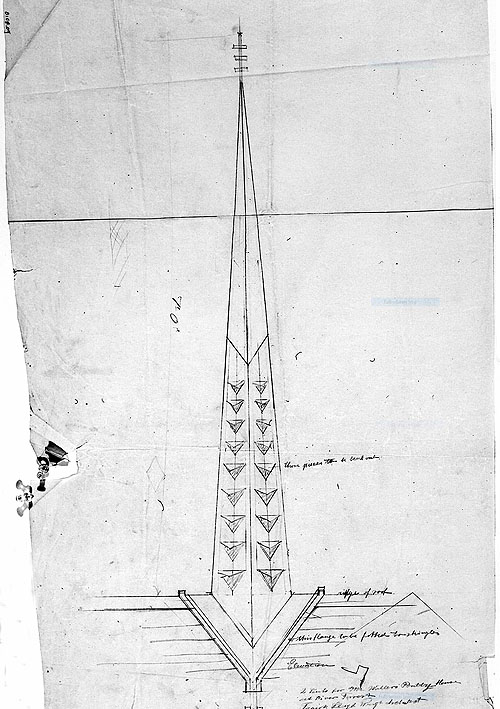 |
|
7) Edward C. Waller Stable &
Poultry House, River Forest, IL (1901 - S.066). Detail of
the Spire "Ventilator" for the Mr. Edward C. Waller Poultry
House. Designed by Frank Lloyd Wright in 1901. Wright does
not specify materials for finishing this spire, but on the
stables he specified copper and shingles. Hand written top
left: "0108.09." Hand written to the right of the spire:
"These pieces to be bent out." Hand written at the base of
the spire: "Ridge of roof. This flange to be fitted to
shingles. Elevation. 2 vents for Mr. Waller’s Poultry House
at River Forest. Frank Lloyd Wright Architect. Oak Park,
IL." Courtesy of the Frank Lloyd Wight Foundation.(S#0049.25.0521) |
| |
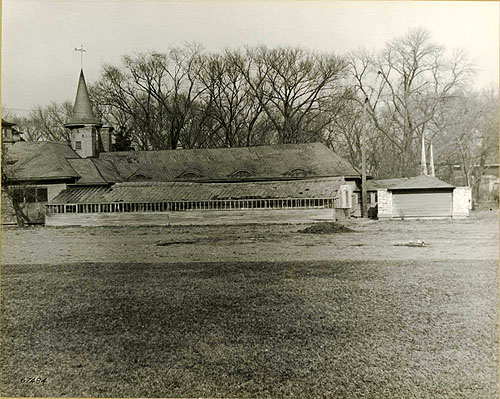 |
|
8) Edward C. Waller Poultry House,
West Elevation, River Forest, IL Circa 1935-1945 (1901 -
S.066). West Elevation of the Edward C. Waller Poultry
House. Designed by Frank Lloyd Wright in 1901. The Poultry
House is the smaller building on the far right and measured
20' x 50'. It is attached to the end of an existing bard and
what appears to be a glass nursery. Like the Waller Gates,
the four corners are stone piers. Like the Stables, there
are two decorative spire "ventilators." The interior of the
Edward C. Waller home, was remodeled by Frank Lloyd Wright
in 1899, and demolished in 1939. All other structures on the
estate except the Waller Gates were also demolished. Text
bottom left: "67484." Photographed by Gilman Lane. Courtesy
of the Art Institute of Chicago. (S#0397.73.0521) |
| |
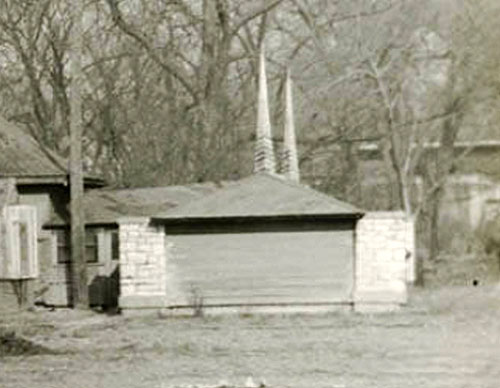 |
| 8A) Detail of the
West Elevation for the Mr. Edward C. Waller Poultry House. |
|
|
|
|
|
|
|
|
|
|
|
EDWARD C. WALLER GATES (1901 - S.065) |
|
|
|
|
Edward C. Waller Gates,
River Forest, IL (1901 - S.065). Set of 25 photographs of
the Waller Gates. Designed by Frank Lloyd Wright in 1901.
Edward C. Waller was a successful Chicago Businessman, real
estate developer and an early client and patron of Frank
Lloyd Wright. Waller developed the Home Insurance Building
at the corner of LaSalle and Adams Streets in 1885. In 1888
Waller built the Rookery Building on the opposite corner of
La Salle and Adams Streets. In 1893-4, Waller sold a lot
across the street from his own house to
William Winslow
(1894 - S.24), who commissioned Wright to design his home.
In 1895, Waller commissioned Wright to design the
Francisco Terrace Apartments
(1895 - S.030) (since demolished) and the
Waller Apartments
(1895 - S.031), considered two of Chicago’s first low-income
housing. In 1898 Waller commissioned Wright to design a home
for himself. It remained a project, but was published in
Inland Architect in 1900. One year later, Wright did remodel
Waller’s
house in River Forest (1899 - S.047). It was
demolished in 1939. In 1901 Waller commissioned Wright to
design the
Lexington Terrace
Complex (project). In 1901 Wright designed the
Waller Gates (S.065) at Auvergne Place at Lake Street, that
lead to his estate. At the same time he also designed the
Poultry House and Stables
(S.066) located on his estate. Wright designed two schemes
for a Summer House (1902 project). Waller’s company managed
the Rookery
Building, and in 1905 Wright redesigned the Lobby
(S.113). In 1913, Wright worked with Waller's son Edward C.
Jr. and
designed
Midway Gardens (S.180).
|
|
The Waller wrought
iron Fencing and Gates, designed by Frank Lloyd Wright in
1901 stand at Auvergne Place at Lake Street, and are all
that remain of the Waller estate. His house, remodeled by
Wright in 1899 (S.047), was demolished in 1939. The Poultry
House and Stables (1899 - S.066) have also been demolished.
Over time, the main center gate and the two side gates were
lost was well as the two gaslight lanterns, most likely gas.
Although the three gates have not been restored, the six
limestone piers and two lanterns, now electric have been.
The wrought iron fencing and gates were most likely produced
by Winslow Bros Ornamental Ironworks, owned by William
Winslow, a client of Wrights and a friend and neighbor of
Waller. The Winslow House can bee seen from the gates. The
lanterns are similar in design to others Wright designed:
Frank L. Smith Bank (1905 - S.111);
Pebbles & Balch (1907 -
S.131); River Forest Tennis Club (1906 - S.119).
One day after photographing the Waller Gates, we
photographed the
Cheney Residence (1903 - S.104). We
discovered two smaller wrought iron gates on either side of
the house, and one large wrought gate in the rear next to
the alley, that match the Waller Gates. It does beg the
question.
Photographed during a visit to Chicago, by Douglas M.
Steiner October 7, 2018. In an effort to expedite adding
these photographs to this website, we have dispensed with a
description for each photograph. Set of 25 high res 20 X
13.5 digital images.
|
|
|
|
|
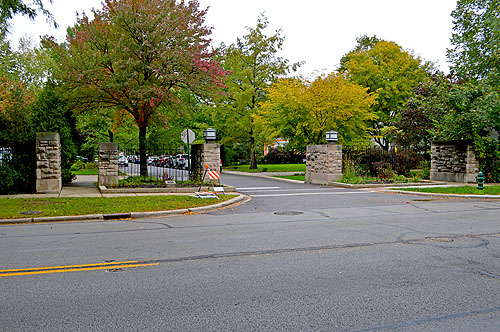 |
| 1) Edward C. Waller Gates, River
Forest, Illinois, 2018 (1901 - S.065). 20 x 13.5 digital
image photographed by Douglas M. Steiner on October 7, 2018.
Copyright 2018, Douglas M. Steiner. (ST#2018.34.0521-1) |
|
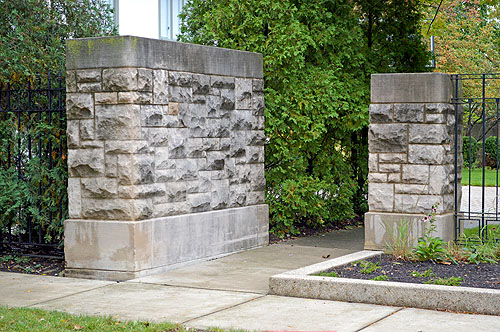 |
| 2) Edward C. Waller Gates, River
Forest, Illinois, 2018 (1901 - S.065). 20 x 13.5 digital
image photographed by Douglas M. Steiner on October 7, 2018.
Copyright 2018, Douglas M. Steiner. (ST#2018.34.0521-2) |
| |
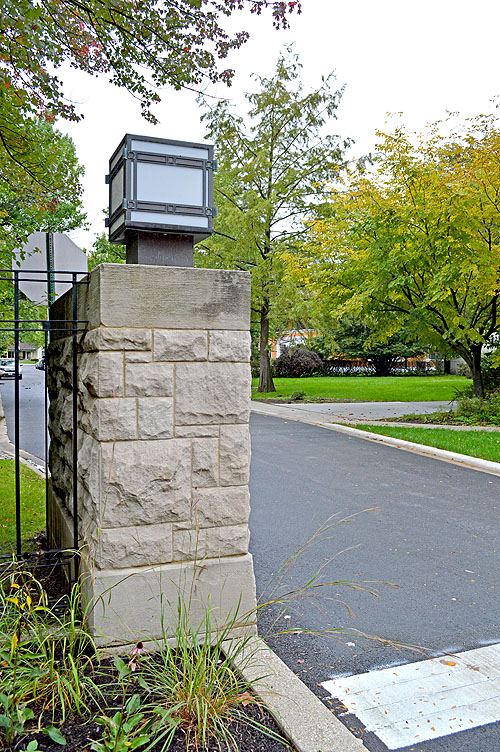 |
| 3) Edward C. Waller Gates, River
Forest, Illinois, 2018 (1901 - S.065). 20 x 13.5 digital
image photographed by Douglas M. Steiner on October 7, 2018.
Copyright 2018, Douglas M. Steiner. (ST#2018.34.0521-3) |
| |
 |
| 4) Edward C. Waller Gates, River
Forest, Illinois, 2018 (1901 - S.065). 20 x 13.5 digital
image photographed by Douglas M. Steiner on October 7, 2018.
Copyright 2018, Douglas M. Steiner. (ST#2018.34.0521-4) |
| |
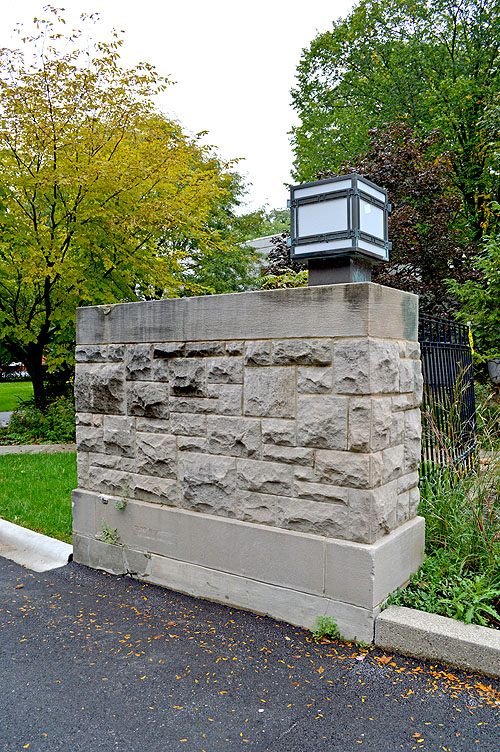 |
| 5) Edward C. Waller Gates, River
Forest, Illinois, 2018 (1901 - S.065). 20 x 13.5 digital
image photographed by Douglas M. Steiner on October 7, 2018.
Copyright 2018, Douglas M. Steiner. (ST#2018.34.0521-5) |
| |
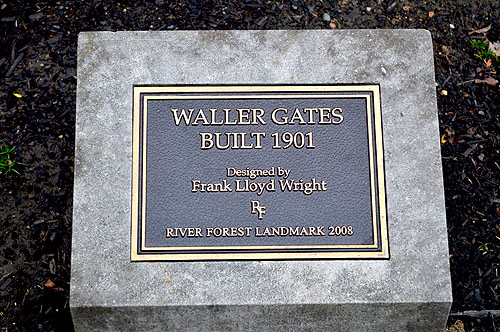 |
| 6) Edward C. Waller Gates, River
Forest, Illinois, 2018 (1901 - S.065). 20 x 13.5 digital
image photographed by Douglas M. Steiner on October 7, 2018.
Copyright 2018, Douglas M. Steiner. (ST#2018.34.0521-6) |
| |
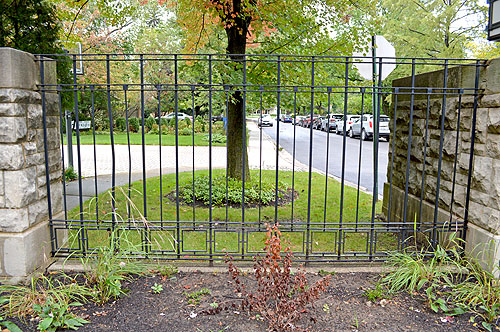 |
| 7) Edward C. Waller Gates, River
Forest, Illinois, 2018 (1901 - S.065). 20 x 13.5 digital
image photographed by Douglas M. Steiner on October 7, 2018.
Copyright 2018, Douglas M. Steiner. (ST#2018.34.0521-7) |
| |
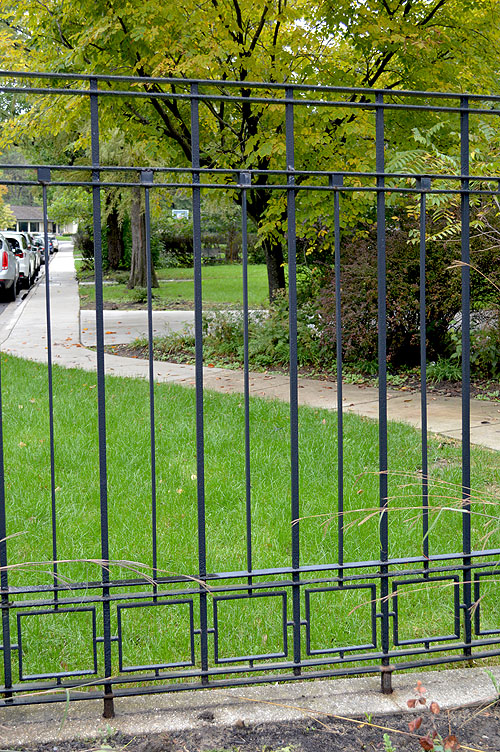 |
| 8) Edward C. Waller Gates, River
Forest, Illinois, 2018 (1901 - S.065). 20 x 13.5 digital
image photographed by Douglas M. Steiner on October 7, 2018.
Copyright 2018, Douglas M. Steiner. (ST#2018.34.0521-8) |
| |
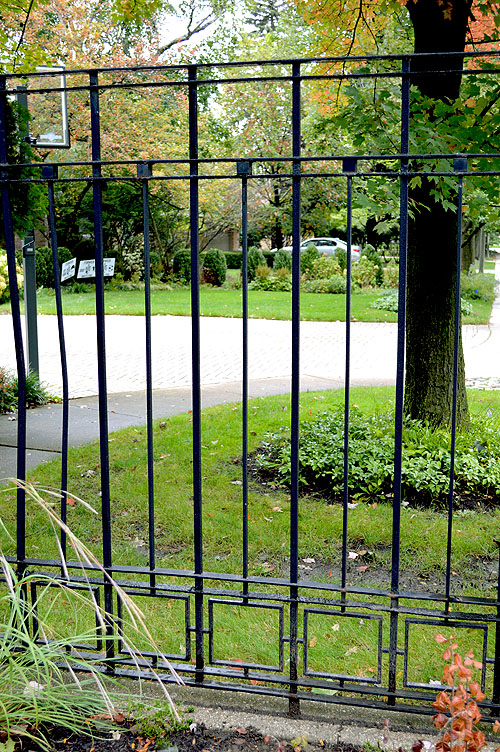 |
| 9) Edward C. Waller Gates, River
Forest, Illinois, 2018 (1901 - S.065). 20 x 13.5 digital
image photographed by Douglas M. Steiner on October 7, 2018.
Copyright 2018, Douglas M. Steiner. (ST#2018.34.0521-9) |
|
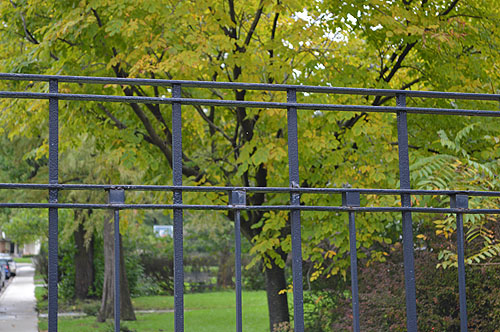 |
| 10) Edward C. Waller Gates, River
Forest, Illinois, 2018 (1901 - S.065). 20 x 13.5 digital
image photographed by Douglas M. Steiner on October 7, 2018.
Copyright 2018, Douglas M. Steiner. (ST#2018.34.0521-10) |
|
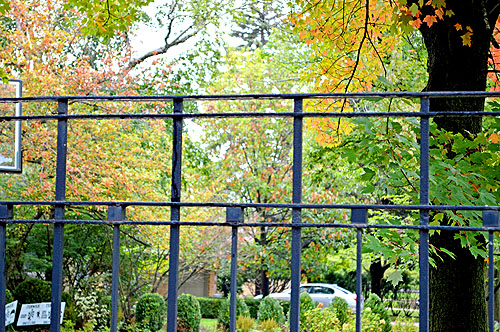 |
| 11) Edward C. Waller Gates, River
Forest, Illinois, 2018 (1901 - S.065). 20 x 13.5 digital
image photographed by Douglas M. Steiner on October 7, 2018.
Copyright 2018, Douglas M. Steiner. (ST#2018.34.0521-11) |
|
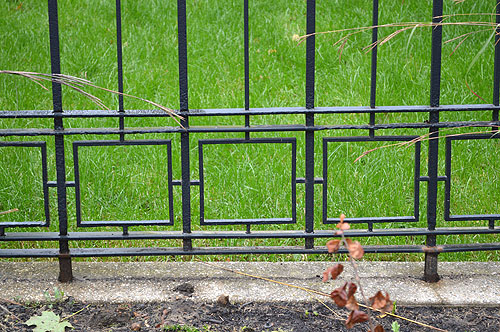 |
| 12) Edward C. Waller Gates, River
Forest, Illinois, 2018 (1901 - S.065). 20 x 13.5 digital
image photographed by Douglas M. Steiner on October 7, 2018.
Copyright 2018, Douglas M. Steiner. (ST#2018.34.0521-12) |
|
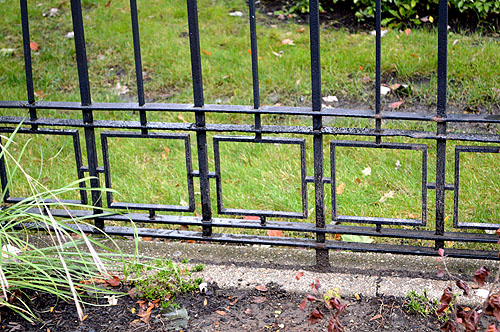 |
| 13) Edward C. Waller Gates, River
Forest, Illinois, 2018 (1901 - S.065). 20 x 13.5 digital
image photographed by Douglas M. Steiner on October 7, 2018.
Copyright 2018, Douglas M. Steiner. (ST#2018.34.0521-13) |
|
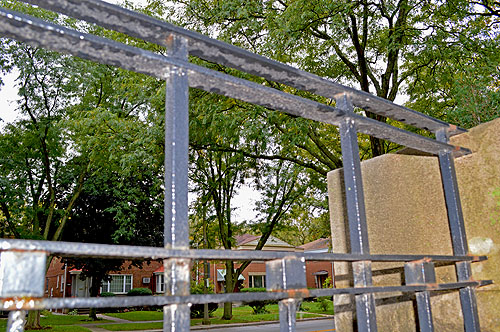 |
| 14) Edward C. Waller Gates, River
Forest, Illinois, 2018 (1901 - S.065). 20 x 13.5 digital
image photographed by Douglas M. Steiner on October 7, 2018.
Copyright 2018, Douglas M. Steiner. (ST#2018.34.0521-14) |
|
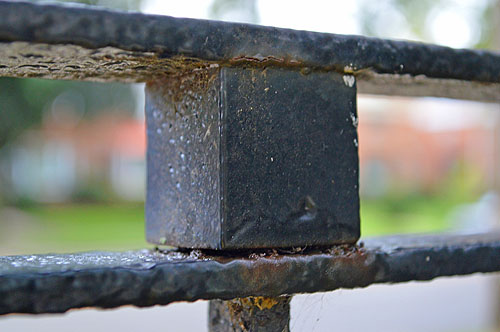 |
| 15) Edward C. Waller Gates, River
Forest, Illinois, 2018 (1901 - S.065). 20 x 13.5 digital
image photographed by Douglas M. Steiner on October 7, 2018.
Copyright 2018, Douglas M. Steiner. (ST#2018.34.0521-15) |
|
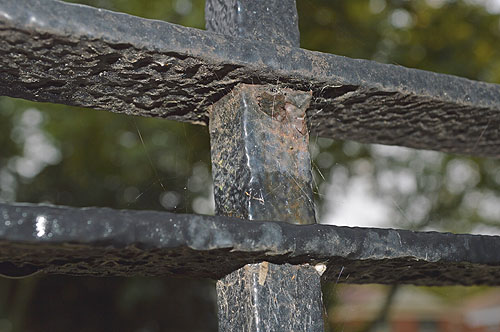 |
| 16) Edward C. Waller Gates, River
Forest, Illinois, 2018 (1901 - S.065). 20 x 13.5 digital
image photographed by Douglas M. Steiner on October 7, 2018.
Copyright 2018, Douglas M. Steiner. (ST#2018.34.0521-16) |
|
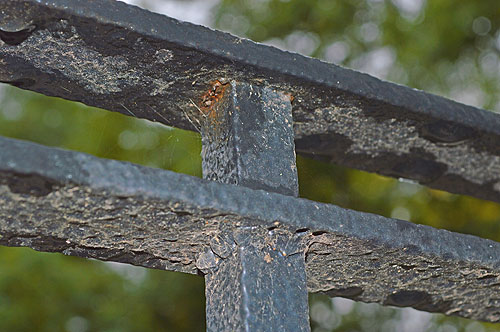 |
| 17) Edward C. Waller Gates, River
Forest, Illinois, 2018 (1901 - S.065). 20 x 13.5 digital
image photographed by Douglas M. Steiner on October 7, 2018.
Copyright 2018, Douglas M. Steiner. (ST#2018.34.0521-17) |
|
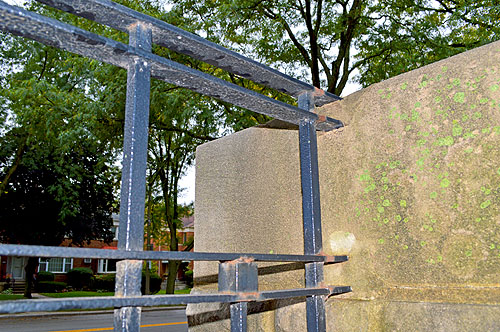 |
| 18) Edward C. Waller Gates, River
Forest, Illinois, 2018 (1901 - S.065). 20 x 13.5 digital
image photographed by Douglas M. Steiner on October 7, 2018.
Copyright 2018, Douglas M. Steiner. (ST#2018.34.0521-18) |
|
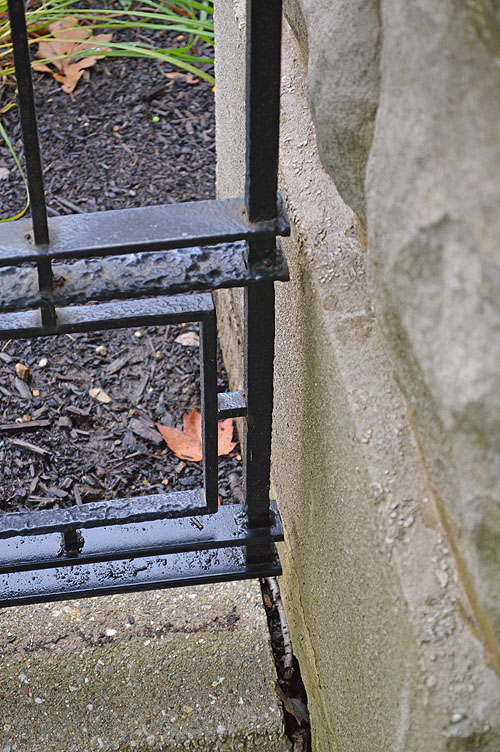 |
| 19) Edward C. Waller Gates, River
Forest, Illinois, 2018 (1901 - S.065). 20 x 13.5 digital
image photographed by Douglas M. Steiner on October 7, 2018.
Copyright 2018, Douglas M. Steiner. (ST#2018.34.0521-19) |
|
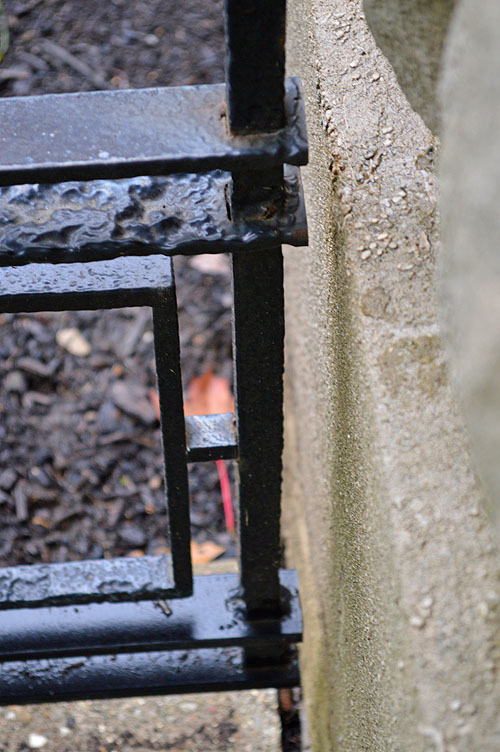 |
| 20) Edward C. Waller Gates, River
Forest, Illinois, 2018 (1901 - S.065). 20 x 13.5 digital
image photographed by Douglas M. Steiner on October 7, 2018.
Copyright 2018, Douglas M. Steiner. (ST#2018.34.0521-20) |
| |
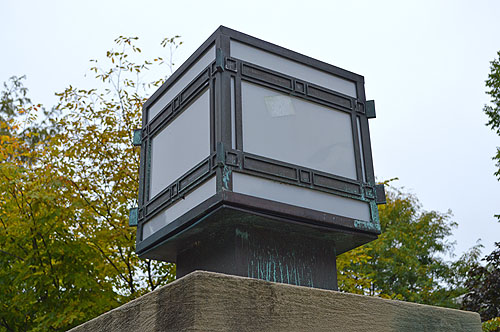 |
| 21) Edward C. Waller Gates, River
Forest, Illinois, 2018 (1901 - S.065). 20 x 13.5 digital
image photographed by Douglas M. Steiner on October 7, 2018.
Copyright 2018, Douglas M. Steiner. (ST#2018.34.0521-21) |
| |
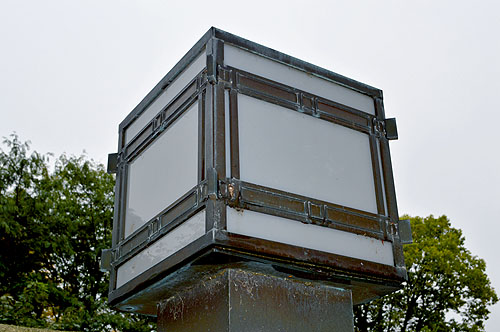 |
| 22) Edward C. Waller Gates, River
Forest, Illinois, 2018 (1901 - S.065). 20 x 13.5 digital
image photographed by Douglas M. Steiner on October 7, 2018.
Copyright 2018, Douglas M. Steiner. (ST#2018.34.0521-22) |
| |
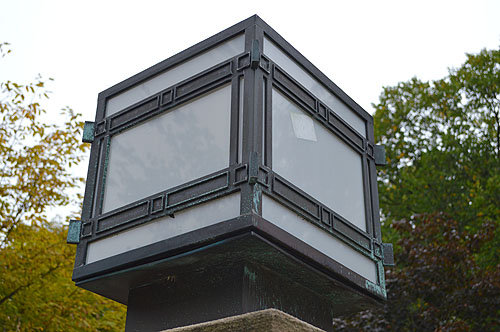 |
| 23) Edward C. Waller Gates, River
Forest, Illinois, 2018 (1901 - S.065). 20 x 13.5 digital
image photographed by Douglas M. Steiner on October 7, 2018.
Copyright 2018, Douglas M. Steiner. (ST#2018.34.0521-23) |
| |
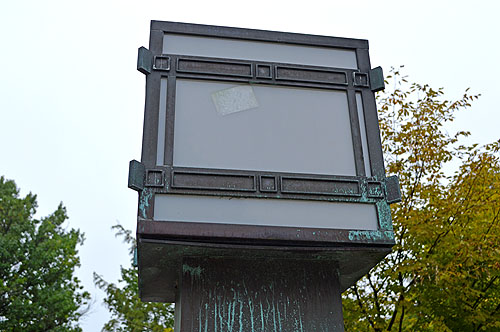 |
| 24) Edward C. Waller Gates, River
Forest, Illinois, 2018 (1901 - S.065). 20 x 13.5 digital
image photographed by Douglas M. Steiner on October 7, 2018.
Copyright 2018, Douglas M. Steiner. (ST#2018.34.0521-24) |
| |
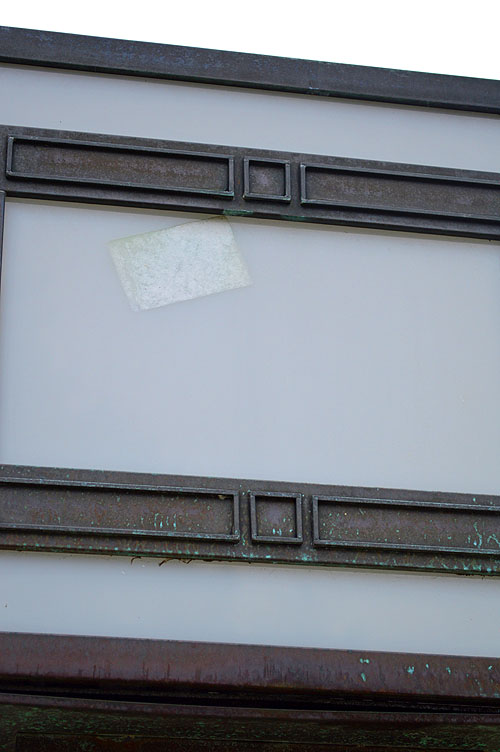 |
| 25) Edward C. Waller Gates, River
Forest, Illinois, 2018 (1901 - S.065). 20 x 13.5 digital
image photographed by Douglas M. Steiner on October 7, 2018.
Copyright 2018, Douglas M. Steiner. (ST#2018.34.0521-25) |
| |
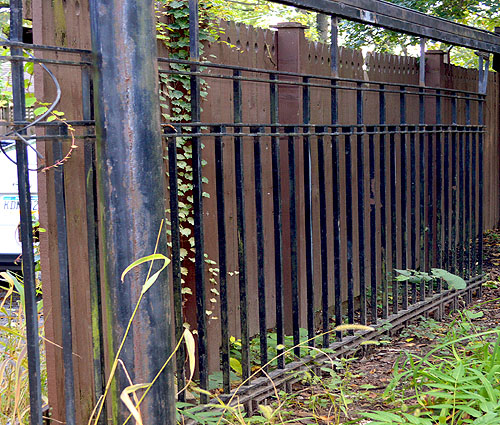 |
Side Note: Edwin H. Cheney Residence,
Oak Park, Illinois, 2018 (1903 - S.104).
One day after photographing the Waller Gates, we
photographed the
Cheney Residence (1903 - S.104). We
discovered two smaller wrought iron gates on either side of
the house, and one large wrought gate in the rear next to
the alley, that match the Waller Gates. It does beg the
question.
20 x 13.5 digital
image photographed by Douglas M. Steiner on October 8, 2018.
Copyright 2018, Douglas M. Steiner. |
|
|
|
|
|
|
|
|
|
|
|
EDWARD C. WALLER BATHING PAVILION (1909 - S.166) |
|
|
|
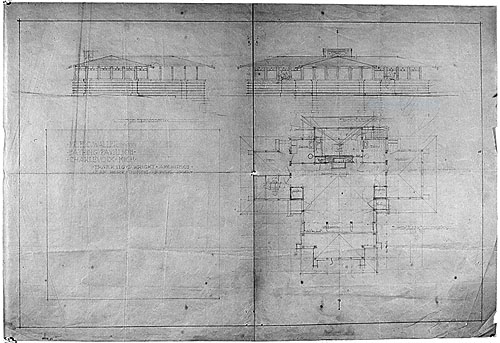 |
|
1)
Edward C. Waller Bathing Pavilion, Charlevoix, Michigan,
Elevation and Plan 1909 (1909 - S.166).
Side and Front Elevations, Floor
Plan. Windows run the entire periphery of the pavilion. Designed
by Frank Lloyd Wright in 1909. Text center left: "Mr. E. C.
Waller. Bathing Pavilion. Charlevoix, Mich. Frank Lloyd Wright,
Architect. Oak Park, Illinois. June 10, 1909." Hand written
lower left: "0916.01." Edward C. Waller was a successful Chicago
Businessman, real estate developer and an early client and
patron of Frank Lloyd Wright. One of his projects was a 2,000
acre parcel of land on Lake Michigan, just north of Charlevoix,
and ran half way Petosky. Immediately North of Charlevoix there
is still a Road named Waller that runs a little over half a
mile. In 1902 Wright created two designs for a large summer
house on the property (FLLW #0212 and #0310). Neither was built.
In 1909 Wright designed a Bathing (swimming) Pavilion on the
property. Located on the beach, it provided a large common area
with fireplace, separate bath/changing room and lounge for men
and women. Behind the fireplace was a kitchen. The front of the
building had a large veranda, balance on either side by large
concrete urns. It was demolished in 1922-23 by fire. Courtesy of
the Frank Lloyd Wight Foundation. (S#0086.30.0521) |
| |
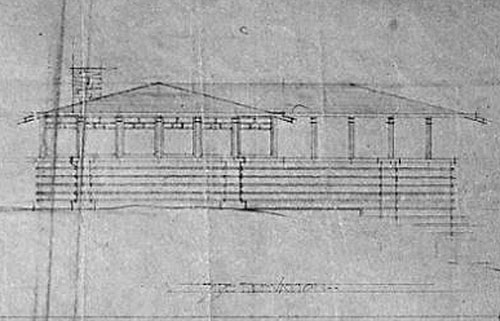 |
|
1A) Detail of the Edward C. Waller
Bathing Pavilion, Side Elevation. |
| |
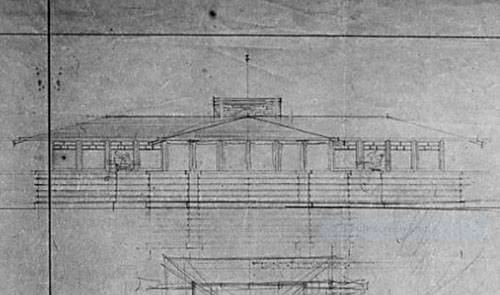 |
|
1B) Detail of the Edward C. Waller
Bathing Pavilion, Front Elevation. |
| |
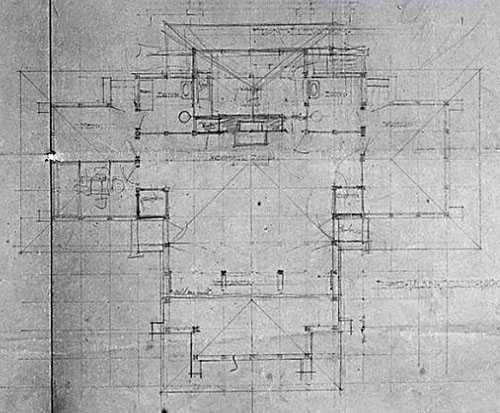 |
|
1C) Detail of the Edward C. Waller
Bathing Pavilion, Plan. |
|
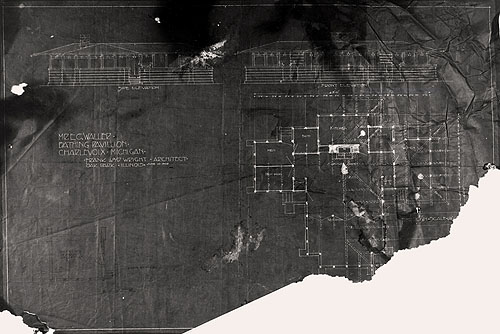 |
|
2)
Edward C. Waller Bathing Pavilion, Charlevoix, Michigan,
Elevation and partial Plan 1909 (1909 - S.166).
Side and Front Elevations, partial
Floor Plan. Windows run the entire periphery of the pavilion.
Designed by Frank Lloyd Wright in 1909. This plan appears to
have enlarged the building. Stairs and a doorway were added on
both sides, leading to the common area. The veranda also appears
to be enlarged. Wright may have presented both versions at the
same time. Comparing the plans to the photograph, it appears
this is the plan that was chosen. Text center left: "Mr. E. C.
Waller. Bathing Pavilion. Charlevoix, Mich. Frank Lloyd Wright,
Architect. Oak Park, Illinois. June 10, 1909." Edward C. Waller
was a successful Chicago Businessman, real estate developer and
an early client and patron of Frank Lloyd Wright. One of his
projects was a 2,000 acre parcel of land on Lake Michigan, just
north of Charlevoix, and ran half way Petosky. Immediately North
of Charlevoix there is still a Road named Waller that runs a
little over half a mile. In 1902 Wright created two designs for
a large summer house on the property (FLLW #0212 and #0310).
Neither was built. In 1909 Wright designed a Bathing (swimming)
Pavilion on the property. Located on the beach, it provided a
large common area with fireplace, separate bath/changing room
and lounge for men and women. Behind the fireplace was a
kitchen. The front of the building had a large veranda, balance
on either side by large concrete urns. It was demolished in
1922-23 by fire. Courtesy of the Frank Lloyd Wight Foundation.
(S#0086.31.0521) |
|
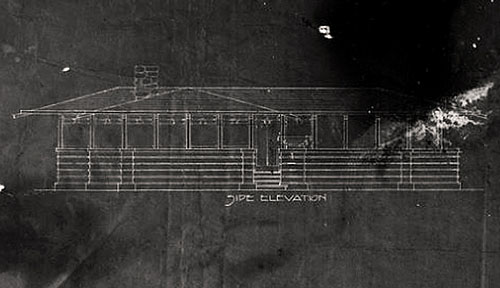 |
|
2A) Detail of the Edward C. Waller
Bathing Pavilion, Side Elevation. |
|
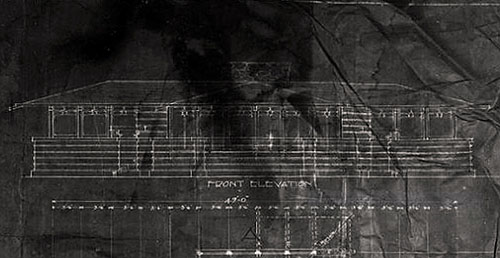 |
|
2B) Detail of the Edward C. Waller
Bathing Pavilion, Front Elevation. |
| |
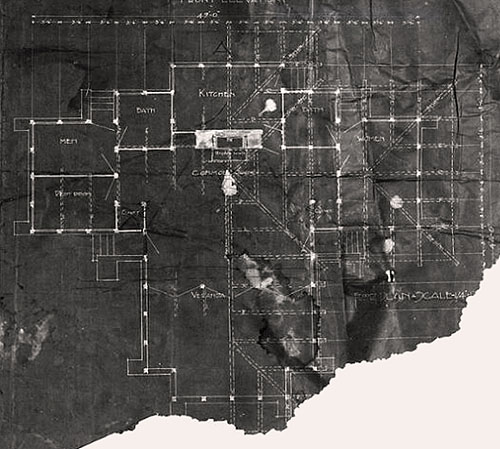 |
|
2C) Detail of the Edward C. Waller
Bathing Pavilion, Plan. |
| |
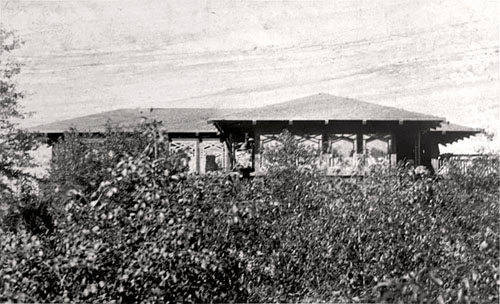 |
|
3)
Edward C. Waller Bathing Pavilion, Charlevoix, Michigan Circa
1910 - Not Dated (1909 - S.166).
View of the side of the Pavilion.
The front is on the left, back is to the right. Windows run the
entire periphery of the pavilion. Designed by Frank Lloyd Wright
in 1909. Edward C. Waller was a successful Chicago Businessman,
real estate developer and an early client and patron of Frank
Lloyd Wright. One of his projects was a 2,000 acre parcel of
land on Lake Michigan, just north of Charlevoix, and ran half
way Petosky. Immediately North of Charlevoix there is still a
Road named Waller that runs a little over half a mile. In 1902
Wright created two designs for a large summer house on the
property (FLLW #0212 and #0310). Neither was built. In 1909
Wright designed a Bathing (swimming) Pavilion on the property.
Located on the beach, it provided a large common area with
fireplace, separate bath/changing room and lounge for men and
women. Behind the fireplace was a kitchen. The front of the
building had a large veranda, balance on either side by large
concrete urns. This photograph appears to be the only one that
has survived. It was demolished in 1922-23 by fire. (S#0094.92.0521) |
|
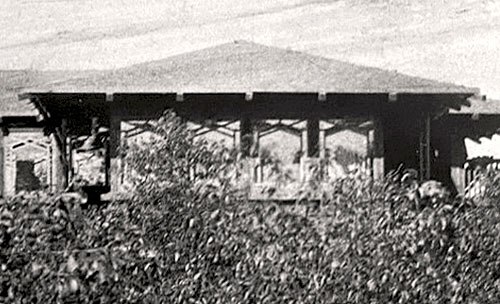 |
|
3A) Detail of the Edward C. Waller
Bathing Pavilion. |
|
|
|
|
|
|
|
|
|
|
|
|

PROCEEDS FROM EVERY SALE GOES TO SUPPORT THE WRIGHT LIBRARY.






























































































